

Crambinae of Iran (Lepidoptera: Pyraloidea, Crambidae)
Crambinae de Irán (Lepidoptera: Pyraloidea, Crambidae)
Crambinae of Iran (Lepidoptera: Pyraloidea, Crambidae)
SHILAP Revista de lepidopterología, vol. 44, núm. 175, 2016
Sociedad Hispano-Luso-Americana de Lepidopterología
Recepción: 16 Enero 2015
Aprobación: 21 Octubre 2015
Abstract: The Iranian species of the subfamily Crambinae are listed. Earlier investigations on the subfamily are summarized and new data on their distribution in Iran together with distribution maps are provided. The genus Friedlanderia Agnew, 1987, and the species Friedlanderia cicatricella (Hübner, [1824]), Agriphila tristella ([Denis & Schiffermüller], 1775), A. poliellus (Treitschke, 1832), Pediasia jucundellus (Herrich-Schäffer, 1849), P. ochristrigellus (Hampson, 1896), Calamotropha lupatus (Meyrick, 1932), Catoptria dimorphellus (Staudinger, 1881) and Talis renetae Ganev & Hacker, 1984, are newly reported from Iran.
Keywords: Lepidoptera, Pyraloidea, Crambidae, Crambinae, distribution maps, new records, Iran.
Resumen: Se presenta un listado de las especies iraníes de la subfamilia Crambinae. Recientes investigaciones sobre la subfamilia han aumentado y proporcionado nuevos datos sobre su distribución en Irán con nuevoas mapas de distribución. Se citan como nuevos para Irán el género Friedlanderia Agnew, 1987 y las especies Friedlanderia cicatricella (Hübner, [1824]), Agriphila tristella ([Denis & Schiffermüller], 1775), A. poliellus (Treitschke, 1832), Pediasia jucundellus (Herrich-Schäffer, 1849), P. ochristrigellus (Hampson, 1896), Calamotropha lupatus (Meyrick, 1932), Catoptria dimorphellus (Staudinger, 1881) y Talis renetae Ganev & Hacker, 1984.
Palabras clave: Lepidoptera, Pyraloidea, Crambidae, Crambinae, mapas de distribución, nuevas citas, Irán.
Introduction
The subfamily Crambinae Latreille, 1810, is represented by almost 2000 known species in 174 genera, and is distributed throughout the world. This subfamily consists of seven tribes, viz. Argyriini Munroe, 1995, Chiloini Heinemann, 1865, Crambini Latreille, 1810, Diptychophorini Gaskin, 1972, Haimbachiini Landry, 1972, Myelobiini Minet, 1982 and Prionapterygini Landry, 1995 (NUSS et al., 2003-2015), of which 370 species in 49 genera have been reported from the Palaeartic Region (BLESZYN´ SKI, 1965).
The oldest records of the Crambinae fauna of Iran go back to 1869, when two species of the genus Crambus, viz. C. saxonellus Zincken (presently belonging to the genus Xanthocrambus) and C. rostellus La Harpe (a junior synonym of C. perlella) were newly reported from Iran, Astrabad (presently known as Gorgan) by LEDERER (1869).
Two years later, again, three additional species and two subspecies of the genus Crambus were reported from Astrabad by the same author (LEDERER, 1871). In 1888, Crambus saxonellus var. carentellus (its type specimen was collected in Hajiabad, Hormozgan Prov.), was described by CHRISTOPH (1888). Subsequently, three further Crambus species and one new subspecies were newly reported and described from Iran by ZERNY (1914).
Catoptria pfeifferi was described as a new species from Iran (Alborz Mt., Sardab valley) by OSTHELDER (1938), and one year later, Crambus inquinatella elbursellus was newly described from Iran (Alborz Mt.) by ZERNY (1939).
TOLL (1948) reported one Eromene species and three species and two subspecies of the genus Crambus from Iran. Of these, one species (C. persellus,considered presently to belong to the genus Pediasia) and one subspecies (C. craterellus defessellus, now belongings to the genus Chrysocrambus) were newly described.
In 1949, three species of genus Eromene (presently known as Euchromius) were reported from Iran by AMSEL (two newly described). In the same article, he described one species and one subspecies of genus Talisfrom Iran (Karaj) (AMSEL, 1949a). Two further Eromene species, one Crambus, and one Ancylolomia species were reported the same year in another article by him (AMSEL, 1949b).
Two species of genus Ancylolomia, A. micropalpella and A. benderella (synonym of A. micropalpella), were described by AMSEL (1951). Three years later another Crambinae species, Surattha stroblei (synonym of S. strioliger Rothschild) was newly described from Iran (Ahwaz) by him (AMSEL, 1954). Ancylolomia westwoodi bitubirosella was described as new from Iran (Iranshahr) by AMSEL (1959). Two Crambinae species, Agriphila microselasella and Pediasia pseudopersella were described from Iran by BLESZYN´ SKI (1959).
AMSEL (1961) reported 35 Crambinae species and one subspecies from Iran, among them two that were newly described. BLESZYN ´SKI (1965), in his study of the Crambinae of the Palaeartic Region, reported 49 Crambinae taxa (including 37 species and 12 subspecies) from Iran (three newly described; only one with an Iranian type locality). In 1970, three species of genus Chilo were newly reported from Iran (MIRZAYANS & KALALI, 1970). EBERT (1973) introduced Chilo suppressalis as a newly recorded species from Iran. In 2001, during the survey by Austrian entomologists of the Golestan National Park in north-east Iran, several species of this family were reported of which only one, Catoptria pinella, was considered as new for the fauna of Iran (WIESER et al., 2001) and Euchromius viettei was newly reported from Iran by ALIPANAH (2003); finally, Mesolia alborzella was described by BASSI (2013) as a new species from Iran.
Iran is a large country with a total surface of 1,648,000 km2, the altitude ranging from 25 m a.s.l. along the Caspian Lowlands to 5,774 m a.s.l. on Mt. Damavand and including the newly added Province, Alborz Province, it consists of 31 Provinces (Fig. 1). The country extends over three phytogeographical regions, namely, the Euro-Siberian regions (Hyrcanian district), Irano-Turanian and Nubo-Sudanian (ZOHARY, 1963, 1973; FREY & PROBST, 1986), plus a small area in the west of Iran which belongs to the Saharo-Arabian Region (Fig. 17). EMELJANOV (1974) in his Palaearctic zoogeographic divisions, considered Iran to be in the Sethian Desert Region and revealed two subregions within it, viz. Saharo-Arabian and Irano-Turanian (which covers more than nine tenths of the land surface of Iran) (Fig. 17). This division was supported by KRYZHANOVSKY (2002) and KONSTANTINOV et al. (2009). The alpine area of Iran belongs to the Irano-Turanian region where the level of endemism is generally high (KLEIN, 1982, 1991).
According to available literature, as many as 64 species of Crambinae have been cited for a country that has a relatively diverse fauna and flora; however, many further species may be expected to occur in this territory.
In the present survey, specimens of subfamily Crambinae have been studied and the data of their distribution in Iran are summarized and illustrated in distribution maps. Although this study is based mostly on material preserved in the Hayk Mirzayans Insect Museum (HMIM) of the Iranian Research Institute of Plant Protection (IRIPP), collected over a period of more than 70 years, it still does not cover all parts of Iran and many regions remain unstudied.
Material and Methods
This study is based mainly on the material preserved in the Hayk Mirzayans Insect Museum, Tehran. Morphological characters were examined using a stereomicroscope (maximum magnification x128). Photographs were taken using a digital still camera DSC-F717 and a Dino-Eye Microscope eyepiece camera. Some images are the result of combining multiple images using the software Combine ZP. Dissection and slide-mounting methods for genitalia were based on those described by CLARKE (1941) and ROBINSON (1976). Preparations were stained with Chlorazol black and mounted in Euparal. The terminology follows that of KRISTENSEN (2003). The distribution maps are based on the museum database of over 694 records collected over the last 70 years, of which the highest number refer to Euchromius ocellea (134 records). Maps were prepared using the software ArcGIS, Version 9.3 software, for all species regardless of their previously introduced subspecies.
The material examined for each species is briefly presented to avoid increasing the length of this paper.
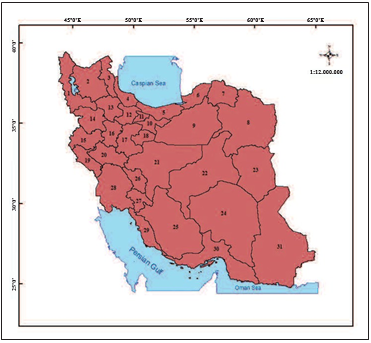
Outline map of the Provinces of Iran: 1) Azarbaijan-e Gharbi. 2) A zarbaijan-e Sharghi. 3) Ardebil. 4) Gilan. 5) Mazandaran. 6) Golestan. 7) Khorasan-e Shoma¯li. 8) Khorasan-e Razavi. 9) Semnan. 10) Tehran. 11) Alborz. 12) Ghazvin. 13) Zanjan. 14) Kordestan. 15) Kermanshah. 16) Hamedan. 17) Markazi. 18) Ghom. 19) Ilam. 20) Lorestan. 21) Esfahan. 22) Yazd. 23) Khorasan-e Jonubi. 24) Kerman. 25) Fars. 26) Chaharmahal va Bakhtiari. 27) Kohgiluyeh va Boyerahmad. 28) Khuzestan. 29) Bushehr. 30) Hormozgan. 31) Sistan va Baluchestan.
Systematics
Tribe Crambini Latreille, 1810
Genus Agriphila Hübner, [1825]
Agriphila bleszynskiella Amsel, 1961 (Fig. 7A)
Agriphila bleszynskiella Amsel, 1961: 326.
Material: Fars Prov. 4 11: Shiraz, Neyriz, Fasa, Zahedshar; Gilan Prov. 2 11: Amarlu; Kohgiluyeh va Boyerahmad Prov. 5 11: Nogol, Yasuj; Khuzestan Prov. one specimen without abdomen: Minu Island; Lorestan Prov. 3 11: Azna; Mazandaran Prov. 5 11, 2 00: Baladeh, Polur; Tehran Prov. 1 0: Damavand.
Distribution: Afghanistan; Iran: Pir-e Zan (it is located in Fars Province; the type locality of the species), Sine Sefid; Turkey (AMSEL, 1961; BLESZYN´ SKI, 1965).
Phenology: The only specimen in Minu Island collected in the April at 10 m elevation; while the remaining specimens collected during the end of July to the early October between 1000-2300 m elevations.
Agriphila cyrenaicellus (Ragonot, 1887) (Fig. 7B)
Crambus cyrenaicellus Ragonot, 1887: 138.
Material: Bushehr Prov. 4 00: Bidkhun, Jam; Fars Prov. 6 11, 6 00: Zahed Shahr, Fasa, Ghasem Abad, Jahrom, Sarvestan; Golestan Prov. 1 1, 1 0: Gorgan; Kerman Prov. 1 1, 2 00: Jiroft, Narab; Khorasan-e Razavi Prov. 1 1: Mashhad; Mazandaran Prov. 4 11, 1 0: Polur.
Distribution: C. Asia; Middle East: Cyprus, Iran (Shiraz, Sarzeh), Iraq, Israel, Jordan, Libya, Syria; N. Africa: Egypt, Tunisia (the type locality of the species); S. Europe: Crete, Greece, Portugal, Sardinia, Sicily, Spain (AMSEL, 1961; BLESZYN´ SKI, 1965; SLAMKA, 2008).
Remarks: Wingspan of the examined specimens, compared to those cited by BLESZYN´ SKI (1965) and FALKOVICH (1997), is slightly larger (20-25 mm) and the length ratio of the labial palpus to the horizontal diameter of the compound eye is 3.5-4.0 which, compared to that cited by BLESZYN´ SKI (1965) (3), is greater.
Phenology: The moth is collected during the August to the November between 600-2200 m elevations.
Agriphila dalmatinellus (Hampson, 1900) (Fig. 7C)
Crambus dalmatinellus Hampson, 1900: 369-370.
Material: Azarbaijan-e Gharbi Prov. 1 0: Poldasht, Maku; Gilan Prov. 4 11, 2 00: Gardaneh-e Heyran, Asalem, Bandar Anzali, Amarlu; Golestan Prov. one specimen without abdomen: Gorgan; Hormozgan Prov. 1 0: Bandar Khamir; Khorasan-e Razavi Prov. 4 11: Neyshabur; Mazandaran Prov. 2 00: Chalak Rud.
Distribution: Europe: Baleares, Bosnia and Herzegovina, Bulgaria, Crete, Croatia, Dalmatia, Greece, Macedonia, S. Italy, Slovenia; Middle East: Cyprus, Iran (Karaj), Iraq (the type locality of the species), Syria; Samarkand (AMSEL, 1961; BLESZYN´ SKI, 1965; SLAMKA, 2008).
Remarks: In 2012, Agriphila beieri Bleszyn´ski was considered by LERAUT as a synonym of A. dalmatinella (LERAUT, 2012). This species firstly reported from Iran (Karaj) by AMSEL (1961) as A. dalmatinella beieri Bleszyn´ski (BLESZYN´ SKI, 1965).
Phenology: The moth is collected during the September (in the North) to the October (in the South) between 20-1600 m elevations.
Agriphila deliella (Hübner, [1813]) (Fig. 7D)
Crambus dalmatinellus Hampson, 1900: 369-370
Material: Golestan Prov. 5 11: Golestan National Park (Tang-e Gol, Golzar); Khorasan-e Shomali Prov. 14 11:Golestan National Park (Almeh, Sulgerd); Mazandaran Prov. 5 11: Gazanak.
Distribution: Afghanistan; Asia Minor; Europe (except British Islands and Greece); Iran; N. Africa; Transcaucasia; W. Siberian plain (BLESZYN´ SKI, 1965; SLAMKA, 2008).
Remarks: Wingspan of the examined specimens is considerably larger (28-37 mm) than that cited by BLESZYN´ SKI (1965) (25-29 mm). In all the examined material, the length ratio of labial palpus to the horizontal diameter of compound eye (4) is slightly less than that cited by BLESZYN´ SKI (1965) (4.0-4.5). So far three subspecies of this species have been described but only one of them, viz. A. deliella asiaticus (Caradja, 1910), is reported from Iran (BLESZYN´ SKI, 1965). There is slight variation in the forewing pattern of the examined males, even in those collected in the same locality. Some specimens are yellowish exactly like A. deliella asiaticus (Fig. 2A), and some are yellowish grey (Fig. 2B). In some of them a dark area is present at the upper angle of the median white line and other are without this dark area (Figs 2A).
Phenology: The moth is collected during the September to the October between 600-2400 m elevations.
Comment: According to NUSS et al. (2003-2015), the type locality of A. deliella asiaticus is NW. Afghanistan (Kuschk); however, as stated by BLESZYN´ SKI (1965), its type locality is Iran: Kuschk. Kuschk is the German spelling of Kushk. There are a number of villages with this name in Iran in the Alborz, Cha¯ ha¯ rmaha¯ l va Bakhtia¯ ri, A¯ zarba¯ ija¯ n-e Sharghi, Fa¯ rs, Hormozga¯ n, Esfaha¯ n, Kerma¯ n, Khuzesta¯ n, Kohgiluyeh va Boyerahmad, Loresta¯ n, Ghazvin, Khora¯ sa¯ n-e Razavi, Khora¯ sa¯ n-e Jonubi, Semna¯ n, Tehra¯ n and Yazd Provinces. The examined material is collected in Golesta¯ n Province in NE. Iran, which is close to both Khora¯ sa¯ n-e Razavi and W. Afghanistan. It is obvious that A. deliella asiaticus is distributed in Iran, but if its type locality is Kushk in Afghanistan, this could be a new record for Iran.
Agriphila inquinatella ([Denis & Schiffermüller], 1775) (Fig. 7E)
Tinea inquinatella Denis & Schiffermüller, 1775: 134.
Material: Azarbaijan-e Sharghi Prov. 1 1: Arasbaran forest (Asheghlu); Fars Prov. 1 1: Estahban.
Distribution: Widely distributed in Europe (including Austria, the type locality of the species); Iran: Astrabad (presently known as Gorgan), Elburs Mt., Karaj, Polur, Shiraz; Near East; Transcaspia (LEDERER, 1871; AMSEL, 1961, BLESZYN´ SKI, 1965; SLAMKA, 2008).
Remarks: Three subspecies of Agriphila inquinatella have hitherto been described, of which only A. inquinatella elbursellus (Zerny, 1939) occurs in Iran, based on the type specimen (Iran, Elburs Mt., Pelur, 2000 m) and the specimens collected in Nissa and Chiraz (German spelling of Nesa¯ and Shira¯z, respectively) (AMSEL, 1961; BLESZYN ´SKI, 1965; NUSS et al., 2003-2015).
In the examined specimens the length ratio of labial palpus to the horizontal diameter of the compound eye is 2-3. Moreover, they have dark scattered spots on the underside of the forewing.
Phenology: This moth is collected in the September and the November between 500-1750 m elevations.
Agriphila microselasella Bleszyn´ski, 1959
Agriphila microselasella Bleszyn´ski, 1959: 112.
Material: No specimens were available for examination in this study.
Distribution: Iran: Elburs Mt., Fars, Hamedan (Soltan Abad) (the type locality of the species), Karaj, Nesa (AMSEL, 1961; BLESZYN´ SKI, 1965).
Agriphila poliellus (Treitschke, 1832) (Fig. 7F)
Chilo poliellus Treitschke, 1832: 113.
Material: Mazandaran Prov. 6 11: Gazanak.
Distribution: Europe: C. Europe (including Hungary; the type locality of the species), Balticum, Denmark, England, France, S. part of Scandinavia, Sardinia, Sicily, Ukraine; Kazakhstan; S. Siberia; Transcaucasia (BLESZYN´ SKI, 1965; SLAMKA, 2008).
Remarks: The wingspan of the examined specimens (25-30 mm) is larger than that cited by
BLESZYN´ SKI (1965) (19-26 mm) and the labial palpus is 4.0-4.5¥ the horizontal diameter of compound eye. The male genitalia of the examined specimens is similar to those illustrated by HANNEMANN (1964) and BLESZYN´ SKI (1965) except for the presence of two specified small thorns in the phallus which are positioned ventroapically (Fig. 3A). Furthermore, although according to FALKOVICH (1997), the costal arm has small dents externally, these are not clear in the genitalia of the examined males (Fig. 3B). This species is newly reported from Iran.
Phenology: The moth is collected in the mid-September at 2350 m elevation.
Agriphila tersellus (Lederer, 1855) (Fig. 8A)
Crambus tersellus Lederer, 1855: 220.
Material: Ardebil Prov. 1 0: Moghan; Azarbaijan-e Gharbi Prov. 1 1: Maku; Fars Prov. 1 1, 3 00: Kamfiruz, Maharlu lake; Khuzestan Prov. 1 1: Ahwaz; Kohgiluyeh va Boyerahmad Prov. 2 11: Sisakht; Tehran Prov. 1 1: Shahriar.
Distribution: Asia Minor; C. & S. Europe (Hungary, Romania and ?Austria); NW. Africa and Canary Islands; Middle East: Iran (Karaj and Pir-e Zan), Lebanon (the type locality of the species), Syria; S. Russia; Transcaucasia (AMSEL, 1961; BLESZYN´ SKI, 1965; SLAMKA, 2008).
Remarks: Wingspan of examined specimens (26-34 mm) is distinctly greater than that cited by BLESZYN´ SKI (1965) (23-26 mm) and the length ratio of labial palpus to the horizontal diameter of the compound eye (3.0-5.5) is slightly less than cited by BLESZYN´ SKI (1965) (4). In the genitalia of the examined males, the gnathos is longer than the uncus.
Two subspecies of this species, viz. A. tersellus tersellus (Lederer, 1855) and A. tersellus hungaricus were introduced by BLESZYN´ SKI (1965) of which the former had been reported from Iran at that time. The latter subspecies was synonymized with A. tersellus tersellus by SLAMKA (2008) and this has also been confirmed by NUUS et al. (2003-2015)
Phenology: The moth is collected during the September to the October between 50-2200 m elevations.
Agriphila tristella ([Denis & Schiffermüller], 1775) (Fig. 8B)
Tinea tristella Denis & Schiffermüller, 1775: 134.
Material: Chaharmahal va Bakhtiari Prov. 2 11: Gandoman; Gilan Prov. 2 00: Gardaneh-e Heyran, Bandar Anzali; Golestan Prov. 1 1: Golestan National Park (Golzar); Khorasane Shomali Prov. 1 1: Golestan National Park (Almeh); Lorestan Prov. 3 11: Azna, Oshtora nkuh; Mazandaran Prov. 2 11: Kordkuy; Tehran Prov. 1 1: Shahriar.
Distribution: Asia Minor; C. Asia; ?China; Europe (including Austria, the type locality of the species); NW India; Transcaucasia; W. Siberian plain (BLESZYN´ SKI, 1965; SLAMKA, 2008).
Remarks: The length ratio of labial palpus of the examined specimens compared to the horizontal diameter of the compound eye is 3.0-4.5, which is slightly less than that cited by BLESZYN´ SKI (1965) (4-5). In the genitalia of the examined males the valvae is broad and slightly narrowed towards the rounded apex (Fig. 3C). In the genitalia of the examined females the bursa copulatrix is more elongated and the ductus bursa is slightly sclerotized in its posterior half with furrows and is narrow anteriorly (Fig. 3D). So far, two subspecies of this species have been described. This species is newly reported from Iran and is represented by the nominotypical subspecies.
Phenology: The moth is collected in the end of August to the early October between 50-1800 m elevations.
Genus Amselia Bleszyn´ski, 1959
Amselia heringi (Amsel, 1935) (Fig. 8C)
Crambus heringi Amsel, 1935: 278-279.
Material: Bushehr Prov. 1 0: Farur Island; Hormozgan Prov. 2 11, 7 00: Gheshm Island, Hormoz Island, Gruk, Khamir; Kerman Prov. 1 0: Jiroft.
Distribution: Middle East: Bahrain, Iran (Ahwaz, Baluchestan [Bandar-e Chabahar], Shiraz, Karaj, Taftan Mt., Sarzeh), Israel (the type locality of the species), Kuwait; Morocco (AMSEL, 1949b, 1961; BLESZYN´ SKI, 1965).
Remarks: There is a distinct variation in the forewing colour of the examined material.
Phenology: The moth is collected during the end of February to the mid-March from the sea level to an elevation of about 900 m; the only female specimen in Farur Island collected in the November.
Genus Catoptria Hübner, [1825]
Catoptria colchicellus (Lederer, 1870) (Fig. 8D)
Crambus colchicellus Lederer, 1870: 52.
Material: A¯ zarba¯ ija¯ n-e Gharbi Prov. 1 0, 1 0: Ma¯ ku.
Distribution: Caucasus and Transcaucasia (the type locality of the species); Iran: Elburz Mt., Lar valley (AMSEL, 1961; BLESZYN´ SKI, 1965); Turkey (GANEV & HACKER, 1985; SLAMKA, 2008).
Remarks: The labial palpus of the examined specimens is 2.5¥ the horizontal diameter of compound eye. As we revealed, in the female genitalia of the studied material, the antrum is larger and sclerotized compared to that of C. mytilella; the ductus bursa is longer and sclerotized with longitudinal furrows and three twists throughout its length (Fig. 4A).
Phenology: The moth is collected in the end of July at 1910 m altitude.
Catoptria dimorphellus (Staudinger, 1881) (Fig. 8E)
Crambus dimorphellus Staudinger, 1881: 81-83.
Material: Alborz Prov. 1 1, 1 0: Karaj.
Distribution: Asia Minor (including Turkey, the type locality of the species); Middle East: Beirut, Cyprus, Syria; S. Europe: Crete, Greece, Sicily, Spain (BLESZYN´ SKI, 1965; SLAMKA, 2008; NUSS et al., 2003-2015).
Remarks: The examined specimens are larger (23-24 mm) than those examined by BLESZYN´ SKI (1965) (18-20 mm). In the genitalia of the examined female, the ductus bursa has two twists throughout its length, one of them in the middle and the other one close to junction with bursa copulatrix (Fig. 4B). This species is here newly reported from Iran.
Phenology: The moth is collected in the end of August at 2000 m altitude.
Catoptria incertellus (Herrich-Schäffer, 1848) (Fig. 8F)
Crambus incertellus Herrich-Schäffer, 1848: 165.
Material: Gilan Prov. 1 1: Astara; Golestan Prov. 1 0: Golestan National Park (Tang-e Gol); Khorasan-e Shomali Prov. 1 0: Golestan National Park (Sulgerd); Mazandaran Prov. 4 11, 1 0: Savadkuh, Kelardasht, Toydarreh, Vandarbon, Tonekabon, Ramsar.
Distribution: Armenia (the type locality of the species); ?Macedonia; NE. Turkey; NW. Iran: Karaj; S. Caucasus (AMSEL, 1961; BLESZYN´ SKI, 1965; SLAMKA, 2008).
Remarks: The length ratio of the labial palpus to the horizontal diameter of the compound eye in the examined material (1.5-2.5) is clearly less than that cited by BLESZYN´ SKI (1965) (3). Generally the wing pattern of the examined specimens is darker than in those examined by FALKOVICH (1997) and BLESZYN´ SKI (1965). As stated by FAZEKAS (2002), three types of cornuti can be found among the C. incertellus populations: cornutus with long tail and triangular point, cornutus with conical thorn, and forked cornutus with a long tail. The last character is observed in the examined specimens. It should be noted that the specimens studied by FAZEKAS (2002) were collected in Iran (Ma¯ zandara¯ n Province: Cha¯ lus).
Phenology: The moth is collected during the May to the September between 400-2100 m elevations.
Catoptria lythargyrella (Hübner, 1796)
Tinea lythargyrella Hübner, 1796: 30.
Material: No specimens were available for examination in this study.
Distribution: Asia Minor; C. Asia; Europe excluding northern and southernmost parts and SE. England (including Germany, the type locality of the species); Iran: Bandar-e Chabahar, Shiraz, Karaj;
S. Siberia; Turkestan (BLESZYN´ SKI, 1965; AMSEL, 1961; SLAMKA, 2008).
Catoptria pfeifferi (Osthelder, 1938) (Fig. 9A)
Crambus pfeifferi Osthelder, 1938: 18-20.
Material: Mazandaran Prov. 1 1: Tonekabon; Tehran Prov. 1 1: Shemshak; Alborz Prov. 1 0: Karaj.
Distribution: Iran (Elburs Mt.: Sardab valley [Vandarbon] and Takht-e Soleyman; the type locality of the species); Turkestan (OSTHELDER, 1938; BLESZYN´ SKI, 1965).
Remarks: Wingspan of the examined specimens is 22-25 mm, length of labial palpus twice that of the horizontal diameter of compound eye. Although the two species, viz. C. pfeifferi and C. colchicellus, are more or less similar in external appearance, they differ in the colour of the fringes of the forewings. In C. pfeifferi (Fig. 2C) they are bright cream, while in C. colchicellus they are darker (Fig. 2D). Moreover, in C. pfeifferi the proximal cell of the forewing is less elongated and its basal side is dentate (Fig. 2C), while in C. colchicellus the cell is clearly elongated and has a smooth basal side (Fig. 2D). Additionally, the lower margin of the forewing in C. pfeifferi fades away (Fig. 2C), while in
C. colchicellus it is distinct (Fig. 2D).
Phenology: The moth is collected in the end of July to the end of August between 250-2700 m elevations.
Catoptria pinella (Linnaeus, 1758) (Fig. 9B)
Phalaena .Tinea. pinella Linnaeus, 1758: 539.
Material: Ardebil Prov. 1 1: Meshkin Shahr; Azarbaijan-e Sharghi Prov. 1 1, 7 00: Ainalu (Arasbaran forest), Kaleybar, Moghan, Tazehkand, Vinagh; Gilan Prov. 31 11, 27 00: Asalem, Astara, Bandar Anzali, Deylaman, Fuman, Hashtpar, Kharjegil, Parehsar, Punel, Pisason, Rahim Abad, Rasht, Shaft, Talesh; Golestan Prov. 7 11, 6 00: Golestan National Park (Tang-e Gol, Koylar, Ghush Cheshmeh, Mazarli), Gorgan, Ali Abad; Mazandaran Prov. 19 11, 21 00: Amol, Amreh, Behak, Behshahr, Eshkatechal, Kelardasht, Polsefid, Ramsar, Sari, Tonekabon, Zirab.
Distribution: Asia Minor; Europe excluding northernmost part; Lebanon; N. Africa; Russia to Japan (BLESZYN´ SKI, 1965; SLAMKA, 2008) and Iran: Golestan National Park (WIESER et al., 2001).
Remarks: Wingspan of the examined specimens nearly the same as that cited by BLESZYN´ SKI (1965) (18-24 mm) except for a single male that has a wingspan of 12 mm and is collected in Gilan Province (Asalem). The length ratio of labial palpus to the horizontal diameter of the compound eye (1.5-2.5) is less than that cited by BLESZYN´ SKI (1965) (3). As far as we know, four subspecies of this species have already been described (BLESZYN´ SKI, 1965). Although C. pinella has been reported from Iran by WIESER et al. (2001), the subspecies had not been defined at that time. Based on the present study the nominotypical subspecies is distributed throughout the country. As we revealed, in some specimens the subterminal line is just like that in C. pinella siciliella Bleszyn´ski and extends to the margin of the tornus while in others it is extended only to the terminal patch, so, that this cannot be a differentiating character of these two subspecies. As stated by FALKOVICH (1997), in the male genitalia the uncus is shorter than the gnathos, but we did not find any significant difference among the examined material and this is in agreement with BLESZYN´ SKI (1965).
Phenology: The moth is collected during the June to the September between 90-2500 m elevations.
Genus Chrysocramboides Bleszyn´ski, 1957
Chrysocramboides craterella (Scopoli, 1763) (Fig. 9C)
Phalaena craterella Scopoli, 1763: 246.
Material: Alborz Prov. 4 11: Asara, Karaj; Azarbaijan-e Gharbi Prov. 9 11: Orumiyeh; Fars Prov. 1 1: Kazerun; Golestan Prov. 3 11 and one specimen without abdomen: Golesta¯ n National Park (Tang-e Gol), Sha¯ hkuh; Kermanshah Prov. 1 1: Eslam Abad-e Gharb; Khorasan-e Shomali Prov. 4 11, 1 0 and one specimen without abdomen: Golestan National Park (Sulgerd); Kohgilouyeh va Boye- rahmad Prov. 1 1: Ya¯suj; Tehran Prov. 1 1: Evin.
Distribution: Asia Minor; C. and S. Europe (including Slovenia, the type locality of the species); also reported from Belgium and SE. England; Middle East: Cyprus, Iran (Gorgan), Jordan, Lebanon; Morocco; Primorye; Transcaucasia; Turkmenistan (LEDERER, 1871; BLESZYN´ SKI, 1965; SLAMKA, 2008).
Remarks: This species was first reported from Iran by LEDERER (1871) as Crambus rorellus which later was synonymized with C. craterella (Scopoli) by BLESZYN ´SKI & COLLINS (1962) and presently is considered as a member of the genus Chrysocramboides (SLAMKA, 2008; NUSS et al., 2003-2015).
Although, as stated by BLESZYN ´SKI (1965), there is clear variation in the shape of the costal arm in the male genitalia, no such variation is noted in any of our observations. The type specimen of C. craterellus defessellus (Toll, 1947), one of the five known subspecies of this species (NUSS et al., 2003-2015), was collected in Iran (Mirabi Mt.) (BLESZYN ´SKI, 1965). Both dark brown and light brown forms (Figs 2E, F) are present among the studied material. These forms can be representatives of the two subspecies, C. craterellus craterellus and C. craterellus defessellus (Scopoli, 1763), respectively based on BLESZYN ´SKI (1965); however we believe that they can not be distinguished as two subspecies. According to BLESZYN ´SKI (1965), the type of C. craterellus defessellus was collected in Khora¯sa¯n Province. Having said this, the populations distributed in Golesta¯n, Khora¯sa¯n-e Shoma¯li, Kerma¯nsha¯h, Fa¯rs and Kohgiluyeh va Boyerahmad Provinces are dark brown and hence referable to C. craterellus craterellus and those occurring in Alborz, A zarbaijan-e Gharbi and Tehra¯n Provinces are similar to C. craterellus defessellus. The colour of the forewing seems to be an unreliable character to separate these two subspecies, and in the absence of enough specimens to check intraspecific variation, the subspecific concept just based on this character and/or such characters must be treated with caution.
Phenology: The moth is collected during the April to the end of June between 900-2150 m elevations.
Genus Chrysocrambus Bleszyn´ski, 1957
Chrysocrambus linetella (Fabricius, 1781) (Fig. 9D)
Tinea linetella Fabricius, 1781: 291.
Material: Alborz Prov. 15 11, 2 00 and three specimens without abdomen: Karaj (Arengeh, Azadbar, Chalus Rd., Kalvan), Taleghan; Ardebil Prov. 24 11, 1 0: Khalkhal, Sabalan, Sareyn; Azarbaijan-e Gharbi Prov. 6 11, 3 00: Orumiyeh; Azarbaijan-e Sharghi Prov. 3 11: Kaleybar, Moghan, Sahand; Chaharmahal va Bakhtiari Prov. 1 1: Shalamzar; Esfahan Prov. 1 1: Khansar; Gilan Prov. 10 11 and 5 11 and one specimen without abdomen: Asalem, Astara , Eshkevar, Rasht; Khorasan-e Razavi Prov. 3 11: Kuh-e Sorkh, Zoshk; Markazi Prov. 1 1: Ashtian; Khorasan-e Shomali Prov. 1 1, 1 0: Ashkhaneh, Bojnurd; Kordestan Prov. 1 1, 3 00: Baneh, Marivan, Ravansar, Sanandaj; Mazandaran Prov. 14 11, 4 00: Amol, Behshahr, Kelardasht, Polsefid, Ramsar, Sari, Tonekabon; Tehran Prov. 6 11: Damavand, Evin, Shahriar.
Distribution: Europe including Albania, Bosnia and Herzegovina, Bulgaria, Corsica, Crete; Croatia, England, France, Greece, Hungary, Italy (the type locality of the species), Macedonia, Montenegro, Rhodos, Romania, Serbia, Sicily, Slovenia, Switzerland; Middle East: Cyprus, Iran (Hamedan, Karaj, Mirabi Mt., Pir-e Zan, Tehran, Sengan, Shiraz, Sine Sefid), Iraq, Jordan, Lebanon, Syria, Turkey; Transcaucasia; Turkestan; Uzbekistan (TOLL, 1948; AMSEL, 1961; BLESZYN ´SKI, 1965).
Remarks: According to BLESZYN´ SKI (1965) and NUSS et al. (2003-2015), Crambus cassentinellus Zeller, and Chrysocrambus cassentinellus pseudocraterellus Bleszyn´ski, which were reported from Iran by TOLL (1948) and AMSEL (1961), respectively, are considered as synonyms of Chrysocrambus linetella (Fabricius) and C. linetella pseudocraterellus Bl eszyn´ ski, correspondingly. SLAMKA (2008) considered A. linetella as a synonym of Chrysocramboides craterellus, while NUSS et al. (2003-2015) leave it at specific rank. However, decision about the taxonomic status of this species would be doubtful without a full study based on typical specimens and/or DNA studies.
Wingspan of the examined specimens is 17-26 mm and labial palpus 4.5-5.0¥ the horizontal diameter of compound eye. This species is represented by three subspecies, of which C. linetella linetella and C. linetella pseudocraterellus, have previously been reported from Iran (BLESZYN´ SKI, 1965). We found some minor variations among the studied populations, especially in the forewing colour and pattern, but this could not convince us to conclude that the mentioned subspecies in Iran are valid.
Phenology: The moth is collected during the mid-March to the second half of July and in October between 45-2700 m elevations.
Chrysocrambus syriellus (Zerny, 1934)
Crambus syriellus Zerny, 1934: 2–3.
Material: No specimens were available for examination in this study.
Distribution: Afghanistan; Middle East including Iran: Karaj (MIRZAYANS & KALAI, 1970), Iraq, Lebanon (the type locality of the species), Palestine, Syria and Turkey (BLESZYN´ SKI, 1965).
Genus Chrysoteuchia Hübner, [1825]
Chrysoteuchia culmella (Linnaeus, 1758) (Fig. 9E)
Phalaena .Tinea. culmella Linnaeus, 1758: 535.
Material: Zanja¯ n Prov. 2 11: Ma¯ hnesha¯ n (Damirlu).
Distribution: Algeria; Europe including Fennoscandia (the type locality of the species probably); Iran; Japan; Kazakhstan; Mongolia; Russia; Transcaucasia; Uzbekistan (AMSEL, 1961; BLESZYN´ SKI, 1965; SLAMKA, 2008).
Remarks: This species was reported from Iran (Hamedan) by AMSEL (1961) as Crambus hortuellus Hübner, the synonym of Chrysoteuchia culmella (BLESZYN´ SKI, 1965). Wingspan of the examined specimens is 17-18 mm and length ratio of labial palpus to the horizontal diameter of compound eye (3.0-3.5) are slightly smaller than those cited by BLESZYN´ SKI (1965) (16-24 mm and 4, respectively). Four subspecies of this species have been described but only one, C. culmella culmella (Linnaeus), is reported from Iran (BLESZYN´ SKI, 1965).
Phenology: The moth is collected in the June at 2212 m altitude.
Genus Crambus Fabricius, 1798
Crambus heringiellus Herrich-Schäffer, 1848
Crambus heringiellus Herrich-Schäffer, 1848: 54.
Material: No specimens were available for examination in this study.
Distribution: C. Asia; Europe: N. and S. Europe (including N. Italy, Sardinia and Sicily), and rare in C. Europe (N. Germany is the type locality of the species); Russia (BLESZYN´ SKI, 1965; SLAMKA, 2008); Iran: Sengan (AMSEL, 1961).
Crambus perlella (Scopoli, 1763) (Fig. 9F)
Phalaena perlella Scopoli, 1763: 243-244.
Material: Ghom Prov. 3 11, 1 0: Vesf; Gilan Prov. 2 00: Masal; Hamedan Prov. 2 11: Barat, Tarik Darreh; Kerman Prov. 2 11: Jiroft; Khorasan-e Razavi Prov. 1 0: Mashhad; Mazandara¯ n Prov. 4 11: Ramsar, Siahbisheh.
Distribution: Armenia; Asia Minor; Europe; Iran: Elburs Mt., Gorgan; N. America; NW. Africa; Russia; N. China to Japan; Hindu Kush Mts; Pamir Mts (LEDERER, 1869, 1871; BLESZYN´ SKI, 1965; SLAMKA, 2008).
Remarks: This species was first reported from Iran by LEDERER (1869) as Crambus rostellus La Harpe. In 1871, C. perlellus var. warringtonellus Stainton and C. perlellus var. rostellus La Harpe were reported from Iran by LEDERER, of which the former was synonymized with Crambus perlella (Scopoli) by BLESZYN´ SKI & COLLINS (1962). Crambus perlellus var. rostellus was first synonymized with Crambus monochromella Herrich-Schäffer by BLESZYN´ SKI (1965), and later was considered as a subspecies of C. perlella (KARSHOLT & RAZOWSKI, 1996; NUSS et al., 2003-2015).
Eleven subspecies of this species are described worldwide (NUSS et al., 2003-2015) but only one, namely, C. perlella aurellus Zerny, is reported from Iran, the type specimen having been collected in Shahkuh in north-east Iran (ZERNY, 1914). This subspecies is also reported from Kuh-i Mirabi (same as Mirabi Mt.) by TOLL (1948) and Kuh-i Binaloud (same as Binalud Mt.), Shiraz, Dasht-Arjan, Cohmer (same as Komehr)-Kakan road, Come (same as Komehr), Elburs Mts., Kuh-i Osman, Nissa (the latter four localities are different spelling of Alburz Mt., Osman Mt. and Nesa, respectively) by AMSEL (1961).
The labial palpus of examined specimens is 3.0-4.5¥ the horizontal diameter of compound eye. The specimens collected in Mashhad (Khorasan-e Razavi Province) have a white labial palpus spotted with brown.
Phenology: The moth is collected during the mid-June to the early August between 2000-2600 m elevations.
Genus Euchromius Guenée, 1845
Euchromius bella (Hübner, 1796) (Fig. 10A)
Tinea bella Hübner, 1796: 29.
Material: Alborz Prov. 1 1, 1 0: Taleghan; Azarbaijan-e Sharghi Prov. 1 1: Maragheh; Chaharmahal va Bakhtiari Prov. 1 1: Shahr-e Kord; Fars Prov. 2 11 and three specimens without abdomen: Bamu, Dehbid, Mamasani, Shiraz, Sivand; Ghazvin Prov. 1 1: Chingher; Kermanshah Prov. 12 11, 6 00: Eslam Abad-e Gharb, Govavar, Kermanshah, Ma hidasht; Kordestan Prov. 1 1, 1 0 and one specimen without abdomen: Ravansar, Sanandaj; Tehran Prov. 3 11, 1 0 and one specimen without abdomen: Evin; Zanjan Prov. 1 0: Bija¯ r.
Distribution: Asia Minor; E. Europe: Bulgaria, Crimea, Macedonia, Serbia Romania; C. Europe (including Hungary, the type locality of the species); S. Europe: Bosnia and Herzegovina, France, Greece, Italy, Montenegro, Spain; Middle East: Iran(Karaj=, Iraq, Israel, Jordan, Lebanon, Palestine, Syria; Morrocco; Russia; Transcaucasia; Tadzhikistan (AMSEL, 1961; BLESZYN´SKI;1965; SCHOUTEN,1992; SLAMKA, 2008)
Remarks: Wingspan of the examined specimens (15-22 mm) is slightly larger than that cited by BLESZYN´ SKI (1965) (16-19 mm) and their labial palpus is 1.0-2.5¥ the horizontal diameter of compound eye. According to FAZEKAS (2011) the frons has a small pointed apex, a character that was not observed in the material examined by us.
Phenology: The moth is collected during the May to the August between 1300-2200 m elevations.
Euchromius cambridgei (Zeller, 1867) (Fig. 10B)
Eromene cambridgei Zeller, 1867: 463.
Material: Azarbaijan-e Gharbi Prov. 1 0 and one specimen without abdomen: Maku, Tabriz;
Bushehr Prov. 1 1, 1 0 and one specimen without abdomen: Ahram, Kangan; Chaha rmaha¯ l va Bakhtiari Prov. 1 0: Sarkhun; Golestan Prov. 1 0: Gorgan; Hormozgan Prov. 4 11, 6 00 and four specimens without abdomen: Bandar Abbas, Isin, Jask, Larak Island, Minab, Sirik; Khorasan-e Razavi Prov. 1 0: Gonabad; Khuzestan Prov. 1 1: Minu Island; Sistan va Baluchestan Prov. 4 00 and one specimen without abdomen: Chabahr.
Distribution: Afghanistan; Africa (including Egypt, the type locality of the species) and Canary Islands; Europe: Baltic Islands, Bosnia and Herzegovina, Corsica, Croatia, Dalmatia, Italy, Macedonia, Montenegro, S. France, Sardinia, Serbia, Slovenia, Spain; Middle East: Bahrein, Iran (Bandar-e Chabahar), Israel, Jordan, Oman, S. Yemen, Saudi Arabia; NW. Pakistan (AMSEL, 1961; BLESZYN´ SKI, 1965; SCHOUTEN, 1992; SLAMKA, 2008).
Remarks: In the genitalia of the examined males the phallus has cornuti and in the females the ductus bursae has furrows.
Phenology: The moth is collected during the March to the June and in the September to the December from the sea level to an elevation of about 1550 m.
Euchromius gratiosella (Caradja, 1910)
Eromene ramburiellus Caradja, 1910: 116.
Material: No specimens were available for examination during this study.
Distribution: Algeria; Armenia; C. Asia (including E. Turkmenistan, the type locality of the species); Europe: Corsica, Crimea, France, Livorno, Spain; Iran (Shahkuh); Lebanon; Mongolia; S. Russia; Turkey; Tuva region (BLESZYN´ SKI, 1965; SCHOUTEN, 1992; SLAMKA, 2008; NUSS et al., 2003-2015).
Euchromius jaxartella (Erschoff, 1874) (Fig. 10C)
Eromene jaxartella Erschoff, 1874: 82.
Material: Azarbaijan-e Gharbi Prov. 1 1, 1 0 and one specimen without abdomen: Orumiyeh, Takab; Azarbaijan-e Sharghi Prov. 1 1: Aras dam; Sistan va Baluchestan Prov. 2 11: Saravan; Golestan Prov. 2 11, 1 0: Gorgan; Khorasan-e Razavi Prov. 1 0 and one specimen without abdomen: Astan-e Ghods farm, Sabzevar; Zanjan Prov. 1 1, 5 00: Daram.
Distribution: C. Asia (including Turkmenistan, the type locality of the species); China; E. Caucasus region; Iran; Mongolia; Tuva region; Urlask; Transcaucasia; S. Pakistan (BLESZYN´ SKI, 1965; SCHOUTEN, 1992; SLAMKA, 2008).
Remarks: The labial palpus of examined specimens is 1.5-2.5¥ the horizontal diameter of compound eye.
Phenology: The moth is collected during the April to the July and in the September from the sea level to an elevation of about 1550 m.
Euchromius keredjella (Amsel, 1949) (Fig. 10D)
Eromene keredjella Amsel, 1949a: 233.
Material: Alborz Prov. 2 00: Taleghan; Chaharmahal va Bakhtiari Prov. 1 1: Lordegan; Hormozgan Prov. 4 11 and one specimen without abdomen. Bandar Abbas, Rudan; Kerman Prov. one specimen without abdomen: Baft; Kermanshah Prov. one specimen without abdomen: Kangavar.
Distribution: Afghanistan; Armenia; Iran: Elburs Mt., Karaj (the type locality of the species), Shiraz; Turkey (AMSEL, 1949a, 1961; BLESZYN´ SKI, 1965; SCHOUTEN, 1992; NUSS et al., 2003- 2015).
Remarks: Wingspan of the examined specimens is 12-21 mm and the labial palpus is 2¥ the horizontal diameter of compound eye. Forewing pattern similar to that described by BLESZYN´ SKI (1965), except that the median line of the examined material is slightly curved at the junction of the costal margin (Fig. 2G). The latter was also noted by AMSEL (1949a).
Phenology: The moth is collected during the early March to the end of August between 150-1750 m elevations.
Euchromius malekalis Amsel, 1961 (Fig. 10E)
Euchromius malekalis Amsel, 1961: 330.
Material: Hormozgan Prov. 1 1: Bastak, Hajiabad; Sistan va Baluchestan Prov. one specimen without abdomen: Khash.
Distribution: Iran: Baluchestan: Takht-e Malek (the type locality of the species); Jordan (AMSEL, 1961; BLESZYN´ SKI, 1965; SCHOUTEN, 1992).
Remarks: Wingspan of the examined specimens is 18-24 mm; the labial palpus is 2.5¥ the horizontal diameter of compound eye. In the forewing of the examined specimens, the lateral sides of the median line are not as described by BLESZYN´ SKI (1965) but are wavy and not smooth (Fig. 2H).
Phenology: The moth is collected in the February, May and the October between 400-1300 m elevations.
Euchromius ocellea (Haworth, 1811) (Fig. 10F)
Palparia ocellea Haworth, 1811: 486-487.
Material: Tehran Prov. 13 11, 18 00 and 17 specimens without abdomen: Damavand, Evin, Varamin; Alborz Prov. 4 11, 2 00 and one specimen without abdomen: Dizin, Karaj, Kahrizak, Shahriar; Ghom Prov. 1 1, 1 0: Ghom lake; Mazandaran Prov. 1 1, 1 0: Chalus, Haraz; Gilan Prov. two specimens without abdomen: Bandar Anzali, Hashtpar; Golestan Prov. 2 00: Dashliborun, Gorgan; Zanjan Prov. 1 1, 2 00: Tarom, Soltaniyeh; Semnan Prov. 1 1, 1 0 and one specimen without abdomen: Shahrud, Shahmirzad; Esfahan Prov. 5 11, 6 00 and one specimen without abdomen: Ardestan, Esfahan, Golpaygan, Kashan, Natanz, Shahr-e Kord, Shahreza; Kerman Prov. 3 11, 3 00 and three specimens without abdomen: Shahr-e Babak, Sarcheshmeh, Bam, Jiroft; Ardebil Prov. 16 11, 10 00 and one specimen without abdomen: Khalkhal, Pars abad; Azarbaija n-e Gharbi Prov. 11 11, 2 00 and two specimens without abdomen: Orumiyeh, Poldasht; Azarbaijan-e Sharghi Prov. 1 1: Aras dam; Khorasa n-e Razavi Prov. 6 11, 8 00 and three specimens without abdomen: Asta n-e Ghods farm, Bajgiran, Ghuchan, Mashhad, Neyshabur, Sarakhs; Khorasan-e Shomali Prov. 7 11, 5 00: Khosraviyeh, Ashkhaneh, Sara¯ ni, Akhlamad, Daregaz; Khora san-e Razavi Prov. 1 1: Fadiheh; Yazd prov. 1 0: Ashkzar; Hamedan Prov. 1 1, 2 00: Arzanfut, Asad Abad, Kabudrahang; Fars Prov. 29 11, 21 00: Darab, Eghlid, Estahban, Fasa, Farashband, Firuz Abad, Jahrom, Kazerun, Kuhmareh, Lar- Jahrom Rd., Maharlu lake, Saadat Shahr, Tang-e Chogan; Loresta n Prov. 3 11, 2 00 and four specimens without abdomen: Azna, Dorud, Sarab-e Doreh; Kermanshah Prov. 2 11, 2 00: Ghasr-e Shirin, Kermanshah, Mahi Dasht; Sistan va Baluchestan Prov. 23 11, 22 00 and one specimen without abdomen: Bampur, Chabahar, Khash, Pishin, Rask, Saravan, Taftan Mt., Zahedan; Kohgiluyeh va Boyerahmad Prov. 2 11, 2 00 and two specimens without abdomen: Noghol, Yasuj; Khuzestan Prov. 7 11, 6 00 and two specimens without abdomen: A badan, Ahwaz, Albaji, Andimeshk, Dezful, Izeh, Malavi, Minu Island and, Susangerd; Hormozgan Prov. 14 11, 6 00 and four specimens without abdomen: Bandar Abbas, Fin, Isin, Geno Mt., Gohreh, Gurband, Hajiabad, Minab, Sirik; Bushehr Prov. 4 11, 2 00 and one specimen without abdomen: Ahram, Bandar Taheri, Bushehr, Kanga¯ n Khormoj.
Distribution: Africa; America; Asia Minor; Australia; C. Asia; C. N. and S. Europe (including England, the type locality of the species); E. Europe: Bulgaria, Crimea, Romania; Canary and Maderia Islands; Middle East: Iran (Ahwaz, Ardekan [presently known as Sepida¯ n], Chabahar, Jahrom, Karaj, Mirabi Mt., Nesa, Pir-e Zan, Shiraz and Taftan Mt.), Iraq, Israel, Jordan, Kuwait, Lebanon, Oman, Palestine, Saudi Arabia, Syria, Yemen; Tian-Shan Mts; Transcaucasia; Turkestan; South Asia: Hawaii, India, Myanmar, Nepal, W. Pakistan (TOLL, 1948; AMSEL, 1949b, 1961; BLESZYN´ SKI, 1965; SCHOUTEN, 1992; SLAMKA, 2008).
Remarks: The upper side of the valvae of the examined males has a serrated swelling (Fig. 4C). In the genitalia of the examined females the antrum is like that described by SCHOUTEN (1992), as a small mushroom-shaped or lip-shaped structure.
Phenology: The moth is collected throughout the year from the sea level to an elevation of about 2800 m.
Euchromius pulverosa (Christoph, 1887) (Fig. 11A)
Eromene pulverosa Christoph in Romanoff, 1887: 47.
Material: Alborz Prov. 1 1 and one specimen without abdomen: A¯ sa¯ ra¯ ; Esfaha¯ n Prov. 1 1: Semirom; Loresta¯ n Prov. 1 0: Dorud; Kohgiluyeh va Boyerahmad Prov. 1 0: Ya¯ suj.
Distribution: Afghanistan; Middle East: Iran (Damavand, Darband, Karaj, Nesa, S. Elburs Mt., Sine Sefid, Shiraz and Tang Ab-e Firuzabad), Iraq, Israel, Lebanon, Syria, Turkey; Transcaucasia (including Ordubad, the type locality of the species) (AMSEL, 1949a, 1961; BLESZYN´ SKI, 1965; SCHOUTEN, 1992).
Remarks: Some of the examined specimens are larger (18-26 mm) than those described by BLESZYN´ SKI (1965) (18-21 mm) and their labial palpus is 1.25-2.50¥ the horizontal diameter of compound eye. Euchromius cochlearellus (Amsel) was synonymized with Euchromius pulverosus by
Phenology: The moth is collected in the end of April to the May and in the September between 1550-2300 m elevations.
Euchromius ramburiellus (Duponchel, 1836) (Fig. 11B)
Crambus ramburiellus Duponchel, 1836: 83.
Material: Fars Prov. one specimen without abdomen: Kazerun; Sistan va Baluchestan Prov. 1 0: Zahedan; Khuzestan Prov. 4 11, 11 00 and three specimens without abdomen: Aba dan, Ahwaz, Albaji, Dezful, Hamid, Hamidiyeh, Shushtar Minu Island; Hormozgan Prov. 1 1 and one specimen without abdomen: Bandar-e Charak, Isin; Esfahan Prov. 2 00: Nain; Bushehr Prov. 1 0 and one specimen without abdomen: Ahram, Dalaki.
Distribution: C. Asia; Europe including Albania, Bosnia and Herzegovina, Bulgaria, Corsica, Croatia, Greece, Italy, Macedonia, Montenegro, Portugal, Romania, S. France, Sardinia, Serbia, Sicily, Slovenia, Spain; Middle East: Cyprus, Iran (Karaj and Jahrom), Iraq, Israel, Jordan, Turkey, Saudi Arabia; N. Africa and Canary Islands (the type locality of the species); S. Russia (AMSEL, 1949a, 1961; BLESZYN´ SKI, 1965; SCHOUTEN, 1992; SLAMKA, 2008).
Remarks: Eromene islamella Amsel which was newly described form Iran (Jahrom) by AMSEL (1949a) is presently considered as a synonym of Euchromius ramburiellus (BLESZYN´ SKI, 1965). The studied specimens are slightly smaller (14-18 mm) than those described by BLESZYN´SKI (1965) (11.5-20.0 mm).
Phenology: The moth is collected during the February to June and in November from the sea level to an elevation about 900 m.
Euchromius rayatella (Amsel, 1949) (Fig. 11C)
Eromene rayatella Amsel, 1949b: 278-279.
Material: Tehran Prov. one specimen without abdomen: Evin, Varamin; Zanjan Prov. 1 0: Tarom; Esfahan Prov. Kuhrang; Khorasan-e Razavi Prov. 1 0 and one specimen without abdomen: Mashhad, Akhlamad.
Distribution: Armenia; Asia Minor; Europe including Bosnia and Herzegovina, Crete, Crimea, Croatia, E. Bulgaria, Greece, Italy, Macedonia, Montenegro, SE. Spain, Serbia, Slovenia; C. Asia; Middle East: Iran, Iraq (Kurdistan, Rayat), Israel, Jordan, Syria (the type locality of the species); S. Russia (BLESZYN´ SKI, 1965; SCHOUTEN, 1992; WIESER et al., 2001; SKLAMKA, 2008).
Remarks: The forewing of the examined specimens is brighter than that in Echromius superbellus and their wingspan is 12-15 mm.
Phenology: The moth is collected during the June and July between 1000-1650 m elevations.
Euchromius superbellus (Zeller, 1849) (Fig. 11D)
Crambus superbellus Zeller, 1849: 314.
Material: Golestan Prov. 1 0: Golestan National Park (Tang-e Gol); Khorasan-e Shomali Prov. 1 0: Shirvan, Hhorasan-e Razavi Prov. 3 11:nBajgiran.
Distribution: S. Europe (including Spain, the type locality of the species). Although it has been reported from Austria, Hungary and Slovenia (BLESZYN´ SKI, 1965; SCHOUTEN, 1992), but according to SLAMKA (2008), their distribution in C. Europe is problematic. It is also reported from Bulgaria and Ukraine; C. Asia; Iran (Elburs Mt.); Transcaspia; Transcaucasia; Turkey (ZERNY, 1939; BLESZYN´ SKI, 1965; SCHOUTEN, 1992; SLAMKA, 2008).
Phenology: The moth is collected in the June and September between 700-1750 m elevations.
Euchromius viettei Bleszyn´ski, 1961 (Fig. 11E)
Euchromius viettei Bleszyn´ski, 1961: 455-456.
Material: Hormozgan Prov. 5 11, 1 0 and one specimen without abdomen: Bandar-e Khamir, Bandar Abbas, Minab.
Distribution: Iran: Hormozgan (ALIPANAH, 2003); Chad (Tibesti Mts); Saudi Arabia (the type locality of the species) (BLESZYN´ SKI, 1965; SCHOUTEN, 1992).
Remarks: Wingspan of the examined specimens is 12-14 mm and the labial palpus is 1.5-2.0¥ the horizontal diameter of compound eye. In all the examined specimens the frons is without a pointed apex.
Phenology: The moth is collected in the May and the November from the sea level to an elevation of about 50 m.
Euchromius vinculellus (Zeller, 1847) (Fig. 11F)
Crambus vinculellus Zeller, 1847a: 760.
Material: Kerman Prov. 2 11, 2 00 and one specimen without abdomen: Jiroft, Shahr-e Babak; Khorasan-e Razavi Prov. 1 1: Daregaz; Fa¯ rs Prov. 2 11, 1 0: Kazerun, Tang-e Chogan; Sistan va Baluchestan Prov. 1 0 and one specimen without abdomen: Khash, Pishin; Khuzestan Prov. 2 11, 1 0: Andimeshk, Dezful; Bushehr Prov. 3 11 and one specimen without abdomen: Ahram, Jam, Kangan; Hormozgan Prov. 29 11, 20 00 and four specimens without abdomen: Bandar Abbas, Bandar Khamir, Bandar Lengeh, Bashagerd, Dalaki, Fariyab, Gohreh, Gurband, Haji Abad, Isin, Larak Island, Minab.
Distribution: Afghanistan; Mediterranean area (including Sicily, the type locality of the species); Middle East: Dead Sea, Iran (Ahwaz, Bandar-e Chabahar, Dalaki bridge, Jahrom, Karaj, Sarzeh, Takht- e Malek and Tang Ab-e Firuzabad), Iraq, Israel, Jordan, Oman, Saudi Arabia and Yemen; NW. Africa; Canary Islands; Kenya; Niger; Transcaucasia (AMSEL, 1949b, 1961; BLESZYN´ SKI, 1965; SCHOUTEN, 1992; SLAMKA, 2008).
Remarks: Wingspan of the examined specimens is 14-20 mm and the labial palpus is 1-2¥ the horizontal diameter of compound eye. As stated by ALIPANAH (2003), in the male genitalia the sacculus has a sharply pointed, long apex, but this character was not observed in some of our examined specimens.
Phenology: The moth is collected during the January to the June, the August to the September an in the November from the sea level to an elevation of about 900 m.
Genus Metacrambus Bleszyn´ski, 1957
Metacrambus carectellus (Zeller, 1847) (Fig. 12A)
Crambus carectellus Zeller, 1847b: 751.
Material: Azarbaija n-e Gharbi Prov. 1 1, 1 0: Takab; Fars Prov. 3 11: Dasht-e Agha , Kamfiruz; Ghazvin Prov. 1 0: Chinger; Gilan Prov. 2 00: Rasht; Golesta n Prov. 2 00: Golestan National Park (Karkuli); Hamadan Prov. 1 1, 1 0: Tarikdarreh, Toyserkan; Kerman Prov. 1 1: Bam; Kermanshah Prov. 1 1, 1 0: Kangavar, Eslam Abad-e Gharb; Khorasan-e Shoma li Prov. 2 00: Ghuchan; Kohgiluyeh va Boyerahmad Prov. 1 1: Sisakht.
Distribution: Asia Minor; C. Asia; Caucasus; Middle East: Iran (Hamedan, Karaj, Pir-e Zan, Sepidan, Shiraz, Sine Sefid, Tehran), Lebanon, Palestine, Syria; S. Europe (including Sicily, the type locality of the species) and southern part of C. Europe; Volga region (AMSEL, 1961; BLESZYB´SKI, 1965; SLAMKA, 2008)
Remarks: Wingspan of examined specimens is slightly larger (16-26 mm) than that cited by BLESZYN´ SKI (1965) (18-21 mm) and the length ratio of the labial palpus to the horizontal diameter of the compound eye (3.5-4.0) is slightly less than that cited by BLESZYN´ SKI (1965) (4.5).
Phenology: The moth is collected during the May to July and in the September from the sea level to an elevation of about 2550 m.
Metacrambus jugaraicae Bleszyn´ski, 1965 (Fig. 12B)
Metacrambus jugaraicae Bleszyn´ski, 1965: 332.
Material: Alborz Prov. 1 1: Savojbolagh; Azarbaijan-e Gharbi Prov. 1 0: Orumiyeh; Azarbaija n-e Shrghi Prov. 1 1, 8 00: Kaleybar; Chaharmahal va Bakhtiari Prov. 1 1: Khushab; Ghom Prov. 1 0: Vesf; Khorasan-e Razavi Prov. 1 1: Mashhad; Kordestan Prov. 1 0: Sanandaj; Lorestan Prov. 1 1: Azna; Tehran Prov. 2 11: Damavand, Firuzkuh.
Distribution: Iran; S. Russia (W. Caucasus region); Turkmenia; W. Kazakhstan (the type locality of the species) (BLESZYN´ SKI, 1965; SLAMKA, 2008).
Remarks: The examined specimens are smaller than those of M. carectellus (wingspan = 15-22 mm). Moreover, the pointed apex of the forewing in M. jugaraicae (Fig. 5A) is more delicate than in the former species. In the examined specimens the labial palpus is 4-5¥ the horizontal diameter of compound eye. In the genitalia of the examined males the gnathos is broad ventrally and slightly longer than that in M. carectellus.
Phenology: The moth is collected in the April and during the June to the August between 340- 2350 m elevations.
Metacrambus kurdistanellus (Amsel, 1959) (Fig. 12C)
Mesocrambus kurdistanellus Amsel, 1959b: 43-44.
Material: Azarbaijan-e Gharbi Prov. 1 0: Ghushchi; Kermanshah Prov. 1 0: Kermanshah; Kordestan Prov. 3 00: S Baneh, N. Marivan; Lorestan Prov. 1 0: Oshtorankuh; Markazi Prov. 1 1: Ashtian.
Distribution: Iran: Barfkhaneh, Mian Kotal, Shiraz; Iraq: Haji Omran (the type locality of the species) (AMSEL, 1959a, 1961; BLESZYN´ SKI, 1965).
Remarks: Wingspan of the examined specimens is larger (25-34 mm) than that cited by BLESZYN´ SKI (1965) (27 mm), and the labial palpus is dark brown apically and its length is 3.0- 3.5¥ the horizontal diameter of compound eye. The genitaliae of the examined males are more or less different from that described by BLESZYN´ SKI (1965) in that the cucullus of the valva has a clear pointed apex and is not rounded at the end (Fig. 4D). Additionally, in the female genitalia of the examined specimens the ductus bursa is broader and shorter than that described by BLESZYN´ SKI (1965) and the junction of the ductus bursae and corpus bursae is not clearly distinguishable (Fig. 6A).
Phenology: The moth is collected in the July between 250-2050 m elevations.
Genus Pediasia Hübner, [1825]
Pediasia alcmena Bleszyn´ski, 1965 (Fig. 12D)
Pediasia alcmena Bleszyn´ski, 1965: 362.
Material: Ardebil Prov. 29 11: Neur lake, Moghan; Azarbaijan-e Gharbi Prov. 4 11: Bazarga n; Khorasan-e Shomali Prov. 4 11; Golestan National Park (Almeh); Semnan prov. 1 1: Shahrud.
Distribution: N. Iran: Shahkuh-e Paeen, the type locality of the species which is located in Golestan Province (BLESZYN´ SKI, 1965).
Remarks: The wingspan of the examined specimens is smaller (16-27 mm) than that cited by BLESZYN ´SKI (1965) (31 mm) and the labial palpus is 2.0-3.5∞ the horizontal diameter of compound eye.
Pediasia contaminella (Hübner, 1796) (Fig. 12E)
Tinea contaminella Hübner, 1796: 24.
Material: Ardebil Prov. 1 1, 2 00: Parsabad, Gardane-ye Heyran, Moghan; Azarbaijan-e Gharbi Prov. 2 11: Maku; Azarbaijan-e Sharghi Prov. one specimen without abdomen: Tabriz; Gilan Prov. 1 11, 6 00 and two specimens without abdomen: Asalem, Amarlu, Fuman, Anzali, Rasht; Golestan Prov. 3 11 and one specimen without abdomen: Gorgan, Ali Abad; Kermanshah Prov. 1 1: Eslamaba d-e Gharb; Khorasa n-e Razavi Prov. 2 11: Daregaz; Mazandaran Prov. 6 11, 2 00: Tonekabon, Behshahr, Amol, Neka; Semnan Prov. 1 0: Shahmirzad; Tehran Prov. 28 11, 8 00 and two specimens without abdomen: Evin.
Distribution: Asia Minor; C. Asia; Europe (excluding northern part); Iran: Gorgan, Karaj, Kopet Dagh, Mirabi Mt., Shiraz, Tehran; Iraq; Krasnoyark region (ZERNY, 1914; TOLL, 1948; AMSEL, 1961; BLESZYN´ SKI, 1965; SLAMKA, 2008; NUSS et al., 2003-2015).
Remarks: The examined specimens are slightly larger (20-27 mm) than that those examined by BLESZYN´ SKI (1965) (21-24 mm) and the length ratio of the labial palpus to the horizontal diameter of the compound eye is slightly shorter (2.75-3.50) than that cited by BLESZYN´ SKI (1965) (3.5-4.0). Although we observed no sexual dimorphism among the studied males and females, BLESZYN´ SKI (1965) stated that both sexes are dimorphic. According to BLESZYN´ SKI (1965) the phallus has a small cornutus and series of brush-like hairs present on its apico-ventral side. Based on the results of this study, the cornuti are of two types: a small, more or less elongated cornutus and a series of tiny thorns positioned longitudinally just next to the elongated cornutus (Fig. 6Ca), as noted by FALKOVICH (1997). Additionally we detected a series of relatively long brush-like spines on the apicoventral side of the phallus (Fig. 6Cb), but no hairs are observed in that area as stated by BLESZYN´ SKI (1965).
Phenology: The moth is collected in the January and during the May to the October from the sea level to an elevationof about 2100 m.
Pediasia desertellus (Lederer, 1855)
Crambus desertellus Lederer, 1855: 220.
Material: No specimens were available for examination during this study.
Distribution: Asia Minor; Europe: E. Roman, ?Portugal, Sicily; Middle East: Cyprus, Iran (Naft Shahr [which is located in Kerma¯ nsha¯ h Prov.], Shiraz, Tang-Ab-e Firuzabad), Iraq, Israel, Jordan, Lebanon (the type locality of the species), Syria; N. Afriaca: Algeria, Mauritania (AMSEL, 1961; BLESZYN´ SKI, 1965; SLAMKA, 2008).
Pediasia fascelinella (Hübner, [1813])
Tinea fascelinella Hübner, 1810-1813: pl. 54 fig. 268 [recte 368].
Material: No specimens were available for examination during this study.
Distribution: Asia Minor; C. Asia; Europe excluding Iberian Penninsula and part of N. Europe. Local in eastern part of C. Europe and westward more frequent; Iran (Shahkuh); Kasnoyark region; Republic of Buryatiya (ZERNY, 1914; SLAMKA, 2008).
Pediasia jucundellus (Herrich-Schäffer, 1849) (Fig. 12F)
Crambus jucundellus Herrich-Schäffer, (1847-) 1849 (-1855), vol. 4: 62.
Material: A¯ zarba¯ ija¯ n-e Gharbi Prov. 1 0: Khoy.
Distribution: C. Asia; Europe: Balkan Penninsula, Greece, Hungary (the type locality of the
species), Romania, Ukraine; Mongolia; S. Russia; S. Siberian plain; Transcaucasia (BLESZYN´ SKI, 1965; SLAMKA, 2008; NUSS et al., 2003-2015).
Remarks: The wingspan of the examined female is 19 mm and its labial palpus is 3.5¥ the horizontal diameter of compound eye. In the female genitalia, in contrast to that cited by BLESZYN´ SKI (1965), the corpus bursae is oval and not rounded and directed upwardly, which is similar to the Hungarian specimens examined by Graziano Bassi (personal correspondence with Graziano Bassi, 2013). This species is newly reported from Iran.
Phenology: The moth is collected in the August at 1825 m elevation.
Pediasia luteella ([Denis & Schiffermuller], 1775)
Tinea luteella Denis & Schiffermüller, 1775: 134.
Material: No specimens were available for examination during this study.
Distribution: Asia Minor; C. Asia; Europe excluding northern part, also not recorded from Spain, Great Britain, Ireland and The Netherlands; Mongolia; S. Siberia; S. Kazakhstan; Iran (Gorgan and Shahkuh) (LEDERER, 1869; ZERNY, 1914; SLAMKA, 2008).
Remark: This species was first reported from Iran (Astrabad) as Crambus luteellus(Lederer 1869), the synonym of Pediasia luteella (NUSS et al., 2003-2015).
Pediasia matricella (Treitschke, 1832) (Fig. 13A)
Phycis matricella Treitschke, 1832: 171-172.
Material: Ardebil Prov. 4 11: Khalkhal, Meshkin Shahr; Azarbaijan-e Gharbi Prov. 1 0: Maku; Golestan Prov. 5 11: Gorgan, Torkman Sahra; Khorasan-e Razavi Prov. 1 1: Mashhad; Lorestan Prov. 5 11: Azna.
Distribution: Europe including ?Austria, Bulgaria, Crimea, Greece, Hungary (the type locality of the species), Macedonia, N. Italy, Portugal, Romania; Middle East: Iran (Kermanshah), Iraq, Jordan, Syria, Turkey; S. Russia; Turkmenistan; Transcaucasia; ?Zabaikalye (AMSEL, 1961; BLESZYN´ SKI,
1965; SLAMKA, 2008).
Phenology: The moth is collected in the September and October from the sea level to an elevation of about 1750 m.
Pediasia numidellus (Rebel, 1903) (Fig. 13B)
Crambus numidellus Rebel, 1903: 406.
Material: Hormozga¯ n Prov. 1 1: Mina¯ b.
Distribution: Algeria: Ouargla-Ghard (the type locality of the species); Middle East including Bahrain, Egypt, Iran (Bandar-e Chabahar, Makran, Sine Sefid) and NE. Saudi Arabia (AMSEL, 1961; BLESZYN´ SKI, 1965).
Phenology: The moth is collected in the January at 19 m elevation.
Pediasia ochristrigellus (Hampson, 1896) (Fig. 13C)
Crambus ochristrigellus Hampson, 1896: 938-939.
Material: Hormozga¯ n Prov. 2 00: Kish Island, Mina¯ b.
Distribution: Pakistan: (the type locality of the species); S. Tunisia (BLESZYN´ SKI, 1965; NUSS et al., 2003-2015).
Remarks: The ductus bursae of the examined females are approximately 3¥ the length of corpus
bursae. This species is newly reported from Iran.
Phenology: The moth is collected in the end of February and end of December between 30-50 m elevations.
Pediasia persellus (Toll, 1948) (Fig. 13D)
Crambus persellus Toll, 1948: 107.
Material: Ardebil Prov. 6 11 and two specimens without abdomen: Khalkha¯ l, Sareyn;
Azarbaijan-e Gharbi Prov. 1 1, 1 0: Maku; Chaharmahal va Bakhtiari Prov. 1 1: Zardkuh; Golestan Prov. 1 1, 2 00: Gorgan; Khorasan-e Razavi Prov. 4 11: Bajgiran; Mazandaran Prov. 2 11: Ramsar; Tehran Prov. 1 1 and two specimens without abdomen: Lar.
Distribution: Crimea; Iran: Karaj, Lar valley, Mirabi Mt. (the type locality of the species), Polur, Shahkuh and Tehran); Kazakhstan; S. Russia (TOLL, 1948; AMSEL, 1961; BLESZYN´ SKI, 1965; SLAMKA, 2008).
Remarks: The labial palpus of the examined specimens is 3.0-4.5¥ the horizontal diameter of compound eye.
Phenology: The moth is collected during the June to the August between 550-2500 m elevations.
Pediasia pseudopersella Bleszyn´ski, 1959 (Fig. 13E)
Pediasia pseudopersella Bleszyn´ski, 1959: 112-114.
Material: Ardebil Prov. 1 1: Mogha¯ n.
Distribution: China (LI & LI, 2011); Iran: Elburs Mt., Karaj (the type locality of the species) (AMSEL, 1961; BLESZYN´ SKI, 1965).
Remarks: The wingspan of the examined male is 30 mm and the length ratio of the labial palpus to the horizontal diameter of the compound eye is distinctly less (2) than that cited by BLESZYN´ SKI (1965) (5).
Phenology: The moth is collected in the June at elevation of about 30 m.
Genus Xanthocrambus Bleszyn´ski, 1957
Xanthocrambus saxonellus (Zincken, 1821) (Fig. 13F)
Chilo saxonellus Zincken, 1821: 254-255.
Material: Alborz Prov. 1 1 1 0: Asara, Karaj; Azarbaijan-e Gharbi Prov. 1 0: Khodaa farin (Arasbaran forest); Khorasan-e Shomali Prov. 2 11, 4 00: Bajgiran, Ghuchan, Mehmanak; Semnan Prov. 1 1: Shahrud; Tehran Prov. 1 1: Lar.
Distribution: Armenia; Asia Minor; Europe: C. Europe (including Germany, the type locality of the species), Balkan Penninsula, Belgium, Italy, S. France, SW. Russia; Iran (Gorgan, Hajiabad, Karaj); Krasnoyarsk region; Transcaucasia (LEDERER, 1869; AMSEL, 1961; BLESZYN´ SKI, 1965; SLAMKA, 2008).
Remarks: This species was first reported from Iran by Lederer (1869) as Crambus saxonellus Zincken from north Iran (Gorgan) and Crambus saxonellus var. carentellus described by CHRISTOPH (1888) from south Iran (Hajiaba¯d). All the examined specimens in this study are collected in the north of Iran which may not be referable to the above-mentioned variety. The wingspan of the examined specimens is 21-26 mm and the labial palpus is 2.5-4.5¥ the horizontal diameter of compound eye. As stated by HANNEMAN (1961), in the female genitalia the ductus bursae is very long, but we observed it is not so long, which also agrees with BLESZYN´ SKI (1965).
Phenology: The moth is collected during the June to the August between 800-2800 m elevations.
Tribe Chiloini Heinemann, 1865 Genus Chilo Zincken, 1817
Chilo christophi Bleszyn´ski, 1965
Chilo christophi Bleszyn´ski, 1965: 112.
Material: No specimens were available for examination during this study.
Distribution: Armenia; C. Asia; E. Asia: Amurland (the type locality of the species), Amur, N. China, S. Ural, Ussuri; Romania; W. Siberian plain (BLESZYN´ SKI, 1965; SLAMKA, 2008); Iran: Caspian Sea area (MIRZAYANS & KALALI, 1970).
Chilo luteellus (Motschulsky, 1866) (Fig. 14A)
Schoenobius luteellus Motschulsky, 1866: 199.
Material: Ardebil Prov. 3 00 and one specimen without abdomen: Pars Abad, Moghan; Azarbaijan-e Gharbi Prov. one specimen without abdomen: Kaleybar; Gilan Prov. 2 11, 1 0 and two specimens without abdomen: Bandar Anzali, Lahijan, Lakan Rd.; Kermanshah Prov. 1 1: Ghasr-e Shirin; Khuzesta¯ n Prov. 7 00: Abadan, Albaji, Dezful.
Distribution: E. and S. Europe including Bulgaria, Crimea, France, Greece, Romania, S. Italy, Sardinia, Spain; E. Asia: Amurland, Primorye, China, Japan, Korea (the type locality of the species);
N. Africa: Algeria and N. Egypt; S. Russia and S. Uralsk region; Syria; Transcaspia; W. & E. Caucasus region (BLESZYN´ SKI, 1965; SLAMKA, 2008; NUSS et al., 2003-2015); Iran: Azarbaijan (MIRZAYANS & KALALI, 1970).
Remarks: The wingspan of the examined males and females are 21-36 mm and 34-42 mm, respectively.
Phenology: The moth collected during the March to the September and in the December from below the sea level to an elevation of about 400 m.
Chilo partellus (Swinhoe, 1885) (Fig. 14B)
Crambus partellus Swinhoe, 1886: 879.
Material: Sistan va Baluchestan Prov. 3 11, 2 00 and one specimen without abdomen: Bampur, Saravan.
Distribution: Afghanistan; Africa; Tropical Asia: India (the type locality of the species); W. Pakistan (BLESZYN´ SKI, 1965; NUSS et al., 2003-2015) and Iran: Baluchestan (MIRZAYANS & KALALI, 1970).
Phenology: The moth is collected in the mid-May and the early July between 490-1165 m elevations.
Chilo phragmitella (Hübner, [1810]) (Fig. 14C)
Tinea phragmitella Hübner, 1805–1810: pl. 43 figs 297–298.
Material: Gila¯ n Prov. 1 0: Bandar Anzali.
Distribution: C. Asia; Europe excluding some Balkan countries and Mediterranean Islands; Iraq; Japan; N. China; ?Primorye; W. Siberian plain (BLESZYN´ SKI, 1965; SLAMKA, 2008) and Iran: Caspian Sea area (EBERT, 1973).
Remarks: The length ratio of the labial palpus to the horizontal diameter of the compound eye is considerably greater (6.5) than that cited by BLESZYN´ SKI (1965) (5).
Phenology: The moth is collected in the early August at 250 m altitude.
Chilo suppressalis (Walker, 1863) (Fig. 14D)
Crambus suppressalis Walker, 1863: 166.
Material: Gila¯ n Prov. 5 00 and one specimen without abdomen: La hijan; Golestan Prov. 5 11, 3 00: Gorga¯ n; Khuzestan Prov. 1 0 and one specimen without abdomen: Safi Abad; Mazandaran Prov. 1 1, 10 00 and two specimens without abdomen: Mahmud Abad, Nur, Tonekabon; Sistan va Baluchestan Prov. 1 0: Saravan.
Distribution: E. Asia: Amurland, China (the type locality of the species), Japan, Korea, Primorye; Europe: Corsica, N. Hungary, Portugal, S. France, Spain; Hawaii; Tropical Asia: India; Indochina, Malaya, Taiwan; W. Siberian plain (BLESZYN´ SKI, 1965; SLAMKA, 2008); Iran: Gilan, Gorgan and Mazandaran (EBERT, 1973).
Remarks: The length ratio of the labial palpus to the horizontal diameter of the compound eye is 2.0-3.5.
Phenology: The moth is collected during the April to the October from below the sea level to an elevation of about 500 m.
Tribe Haimbachiini Gaskin, 1972 Genus Pseudobissetia Bleszyn´ski, 1959
Pseudobissetia terrestrellus (Christoph, 1885) (Fig. 14E)
Chilo terrestrellus Christoph, 1885: 151.
Material: Fars Prov. 1 0: Shiraz.
Distribution: E. and S. Europe including Bulgaria, Greece, Romania, S. Italy, Sicily and Spain; E. Caucasus region; Middle East: Iran (Bandar-e Chabahar and Sine Sefid), Jordan, Syria; Primorye; Transcaspia (including Turkmenistan, the type locality of the species); Transcaucasia; Tunisa (AMSEL, 1961; BLESZYN´ SKI, 1965; SLAMKA, 2008; NUSS et al., 2003-2015).
Remarks: The wingspan of the examined female is 30 mm and its labial palpus is 4.5¥ the horizontal diameter of compound eye.
Phenology: The moth is collected in the mid-May at 1150 m altitude.
Genus Friedlanderia Agnew, 1987
Friedlanderia cicatricella (Hübner, [1824]) (Fig. 14F)
Tinea cicatricella Hübner, 1823–1824: pl. 68 fig. 455.
Material: Kermanshah Prov. 1 0: Eslam Abad-e Gharb.
Distribution: Europe including C. and S. countries, Balticum, Belgium, S. England, The Netherlands and Ukraine; Kazakhstan; S. Russia and W. Siberian plain; Syria; Transcaucasia (BLESZYN´ SKI, 1965; SLAMKA, 2008).
Remarks: The wingspan of the examined male is 30 mm and its labial palpus is 3.5¥ the horizontal diameter of compound eye. This species was previously assigned to the genus Acigona Hübner, [1825], but later transferred to the genus Friedlanderiaby AGNEW (1987). The genus and species are here newly reported from Iran.
Phenology: The moth is collected in the early July at 1500 m elevation.
Genus Thopeutis Hübner, [1818]
Thopeutis galleriellus (Ragonot, 1892) (Fig. 15A)
Cephis galleriellus Ragonot in Staudinger, 1892: 295-296.
Material: Bushehr Prov. 1 0: Bandar-e Deylam; Fars Prov. 29 11, 11 00: Bakhtegan lake, Parishan lake; Golestan Prov. 1 1: Gorgan; Khuzestan Prov. 1 1, 29 00: Aba dan, Ahwaz; Sistan va Baluchestan Prov. 18 11, 49 00: Khajeh Mt., Zabol.
Distribution: Asia Minor; Caucasus; Europe including ?Bulgaria, Montenegro, Romania, S. France, Sardinia, Spain, Ukraine; India and Sri Lanka; Iran; Iraq; Israel; N. Africa (including Tunisia, the type locality of the species); N. America; S. Russia (BLESZYN´ SKI, 1965; SLAMKA, 2008; NUSS et al., 2003-2015).
Remarks: The wingspan of the males and females are 25-27 mm and 26-40 mm, respectively. Although FALKOVICH (1997) referred to variation in the forewing colour (from dirty white to brown) and the silky white colour of the hindwing, the males are darker than the females in both the fore- and hindwing in all the studied material.
Phenology: The moth is collected during the April to the June and at the September to the October from below the sea level to an elevation of about 1950 m.
Tribe Prionapterygini B. Landry, 1995
Genus MesoliaRagonot in Joannis & Ragonot, 1889
Mesolia alborzella Bassi, 2013
Mesolia alborzella Bassi, 2013: 140,142.
Material: No specimens were available for examination during this study. Distribution: Iran (S. Shimshak; an erroneous spelling of Shemshak) (BASSI, 2013).
Genus Surattha Walker, 1863
Surattha soudanensis Hampson, 1919 (Fig. 15B)
Surattha soudanensis Hampson, 1919 b: 68.
Material: Hormozga¯ n Prov. 1 0: Henga¯ m Island.
Distribution: Afghanistan; Bahrain; Iran (Bandar-e Chabahar); Saudi Arabia; Sudan (the type locality of the species) (AMSEL, 1961; BLESZYN´ SKI, 1965).
Phenology: The moth is collected in the early March.
Surattha strioliger Rothschild, 1913
Surattha strioliger Rothschild, 1913: 135.
Material: No specimens were available for examination during this study.
Distribution: Iran: Ahwaz; Saudi Arabia; Western part of C. Sahara (the type locality of the species) (AMSEL, 1954; BLESZYN´ SKI, 1965).
Remark: Surattha stroblei Amsel which was described form Iran (Ahwaz) by AMSEL (1954), now is considered a synonym of Surattha strioliger Rothschild (BLESZYN´ SKI, 1965).
Genus Talis Guenée, 1845
Talis quercella ([Denis & Schiffermüller], 1775) (Fig. 15C)
Tinea quercella Denis & Schiffermüller, 1775: 134.
Material: Ardebil Prov. 1 1: Moghan; Azarbaijan-e Gharbi Prov. 2 11, 1 0: Bazargan, Maku, Poldasht, Tazeh Kand; Azarbaija n-e Sharghi Prov. 7 11: Bostan Abad, Maragheh, Siahchaman, Tabriz; Tehran Prov. 1 1: Shahriar.
Distribution: Asia Minor; C. Asia; southern part of C. Europe (including Austria, the type locality of the species). It is also reported from ?Bavaria, Bulgaria, Poland, Romania, SW. & C. part of European Russia, Sardinia, Sicily, Spain and Ukraine; Iran (Elburs Mt. and Karaj); Iraq; Mongolia; NW. Africa; NW. China; SW. Siberia (AMSEL, 1949a, 1961; BLESZYN´ SKI, 1965; SLAMKA, 2008).
Remarks: Talis iranica which was described form Iran (Karaj) by AMSEL (1949a) is now considered as a subspecies of Talis quercella iranica Amsel (BLESZYN´ SKI, 1965). The wingspan of the examined specimens is 27-35 mm and the labial palpus is 1.5-2.0¥ the horizontal diameter of compound eye. Although according to BLESZYN´ SKI (1965), the females have a reduced forewing pattern, in the single female examined, the forewing (Fig. 5B) is darker than that of the males (Fig. 5C) and has a distinct pattern. In the genitalia of the examined males the saccular processes are more or less asymmetrical and pointed apically (Fig. 6D). Four subspecies of this species are already known but only one, T. quercella iraniaca is reported from Iran (Karaj) so far.
Phenology: The moth is collected during the June to the September between 30-1750 m elevations.
Talis renetae Ganev & Hacker, 1984 (Fig. 15D)
Talis renetae Ganev & Hacker, 1984: 249-250.
Material: Khorasa n-e Razavi Prov. 2 11: Mashhad; Khorasa n-e Shomali Prov. 4 11: Golesta¯ n National Park: (Almeh, Sulgerd); Mazandaran Prov. 2 11: Chalus, Tonekabon.
Distribution: Turkey: Ankara (the type locality of the species) (GANEV & HACKER, 1984). Remarks: This species is newly reported from Iran.
Phenology: The moth is collected during the June and from September to October between 1100- 1600 m elevations.
Unplaced genera
Genus Ancylolomia Hübner, [1825]
Ancylolomia micropalpella Amsel, 1951 (Fig. 15E)
Ancylolomia micropalpella Amsel, 1951: 526.
Material: Bushehr Prov. 1 1: Khalij-e Nayband; Hormozgan Prov. 3 11, 1 0: Bandar Abbas, Geno.
Distribution: Bahrain; Iran including Baluchestan (Chabahar), Larestan (Sarzeh, the type locality of the species); Saudi Arabia (AMSEL, 1951, 1961; BLESZYN´ SKI, 1965).
Remarks: The wingspan of the examined specimens (21-26 mm) is considerably less than that cited by BLESZYN´ SKI (1965) (27-33 mm) and the labial palpus is 1.0-1.2¥ or less than the horizontal diameter of compound eye; while in the specimens examined by BLESZYN´ SKI (1965) it was 2. Although the valvae in the male genitalia have elongated hairs, according to BLESZYN´ SKI (1965), this character was not clear in the studied males (BLESZYN´ SKI, 1965).
Phenology: The moth is collected during the October to December from the sea level to an elevation of about 650 m.
Ancylolomia palpella ([Denis & Schiffermüller], 1775) (Fig. 15F)
Tinea palpella Denis & Schiffermüller, 1775: 134.
Material: Alborz Prov. 1 1, 1 0: Mala¯ rd, Karaj; Ardebil Prov. 17 11, 18 00: Moghan;
Azarbaijan-e Gharbi Prov. 1 1, 3 00: Orumiyeh, Maku, Poldasht; Azarbaija n-e Sharghi Prov. 1 1, 1 0:
Kaleybar; Esfahan Prov. 1 1, 4 00: Delijan; Fars Prov. 27 11, 31 00: Maharlu lake, Estahban, Sarvestan, Neyriz, Sepidan, Shiraz, Dasht-e Arzhan, Abadeh; Ghazvin Prov. 1 1: Rudbar, Dasht-e Agha; Gilan Prov. 2 00: Bandar Anzali; Golestan Prov. 32 11, 11 00: Gorga n; Khorasa n-e Shomali Prov. 38 11: Golestan National Park (Almeh, Sulgerd); Hormozgan Prov. 2 11, 3 00: Farur Island, Geno Mt., Bandar Abbas; Khorasa n-e Razavi Prov. 1 1, 1 0: Neyshabur; Kerman Prov. 1 1, 2 00: Jiroft, Shahr-e Babak, Rabar, Lalehz ar; Ilam Prov. 3 11: Mishkhas; Kermanshah Prov. 1 1: Kermansha h; Kohgiluyeh va Boyerahmad Prov. 2 00: Ya suj; Lorestan Prov. 20 11, 3 00: Azna , Oshtorankuh, Aligudarz; Mazandaran Prov. 2 11: Chalus, Gazanak; Tehran Prov. 47 11, 11 00: Evin, Varamin, Shahriar.
Distribution: Asia Minor; Canary Islands; C. and S. Europe (including Austria, the type locality of the species), but rare; E. Europe: Belgium, Bulgaria, Macedonia, Romania, Serbia, Ukraine; Kazakhstan; Middle East: Iran (Karaj, Kermanshah, Pir-e Zan, Shiraz, Sine Sefid), Iraq, Lebanon, Palestine, Syria; Russia; Transcaucasia (AMSEL, 1961; BLESZYN´ SKI, 1965; SLAMKA, 2008).
Remarks: The wingspan of the examined males is 25-38 mm and that of the females is 26-48 mm. Moreover, the length ratio of the labial palpus to the horizontal diameter of the compound eye (3.5-6.0) is more variable than that cited by BLESZYN´ SKI (1965) (4.5-5.5). Forewing pattern of the examined specimens consists of two different types in the females, even in the same locality. Some females are quite similar to the males (Fig. 5D) but in others the wing colour is amber with an indistinct pattern and a dark brown longitudinal line in the lower half of the forewing, starting from the base and extending towards the subterminal line, exactly comparable to the wing pattern of A. palpella syriaca Rebel, 1911 (Fig. 5E). Up to now only one of the four described subspecies of this species, A. palpella palpella ([Denis & Schiffermüller], 1775) has been reported from Iran. In the genitalia of the examined females the bursa copulatrix is without any clear sclerotized area, as indicated by BLESZYN´ SKI (1965).
Phenology: The moth is collected in February and during the April to the November from the sea level to an elevation of about 2750 m.
Ancylolomia pectinatellus (Zeller, 1847) (Fig. 16A)
Crambus pectinatellus Zeller, 1847: 747.
Material: Ardebil Prov. 4 11: Moghan; Fars Prov. 8 11, 2 00: Estahban, Ghasem Abad, Shiraz, Tang-e Chogan, Miandeh, Fasa, Zahed Shahr.
Distribution: Asia Minor; Europe including Balkan Penninsula, Bosnia and Herzegovina, Croatia, ?Hungary, Macedonia, Malta, Montenegro, S. Italy, Serbia, Sicily (the type locality of the species) and Slovenia; Middle East: Cyprus; Iran (Ahwaz, Bandar-e Imam Khomayni, Shiraz), Iraq, Palestine, Syria (AMSEL, 1949b, 1961; BLESZYN ´SKI, 1965; SLAMKA, 2008). Remarks: The examined specimens are slightly smaller (22
Remarks: The examined specimens are slightly smaller (22-27 mm) than those examined by BLESZYN´ SKI (1965) (25-31 mm) and the labial palpus is 2.5-4.0¥ the horizontal diameter of compound eye.
Phenology: The moth is collected during the August to the November between 40-1750 m elevations.
Ancylolomia tentaculella (Hübner, 1796) (Fig. 16B)
Tinea tentaculella Hübner, 1796: 26-27.
Material: Ardebil Prov. 21 11, 1 0: Moghan; Bushehr Prov. 2 11: Jam; Fars Prov. 1 1: Shiraz; Golestan Prov. 2 11: Gorgan; Gilan Prov. 2 11: Rahim Abad, Talesh; Kermanshah Prov. 1 1: Ghasr-e Shirin; Mazandaran Prov. 1 1: Kelardasht.
Distribution: Asia Minor; C. and S. Ural regions; Europe: S. Europe (including Italy, the type locality of the species), Bulgaria, ?Hungary, Macedonia, Serbia, SE. England, Slovenia, Switzerland, Ukraine; Russia; Middle East: Iraq, Lebanon, Syria (BLESZYN´ SKI, 1965; SLAMKA, 2008) and Iran (Azarbaijan) (MYRZAYANS & KALALI, 1970).
Remarks: The wingspan of the examined specimens 26-40 mm, and the labial palpus is 2.5-4.5¥ the horizontal diameter of compound eye; according to BLESZYN´ SKI (1965) they were 29-38 mm and 3.0-
3.5 mm, respectively. The males of A. palpella and A. tentaculella can easily be separated by the shape of the antennae, while the diagnostic character in the females is found in the labial palpus. In A. palpella it is longer and more slender, but in A. tentaculella it is shorter and thicker. Moreover, the maxillary palpus in
A. palpella is slender while in A. tentaculella it is shorter with a rounded apex. As stated by BLESZYN´ SKI (1965), in A. tentaculella the dorsal apophyses are longer compared to those of A. palpella, but we found no considerable differences between the specimens we examined in this regard.
Phenology: The moth is collected during the early June to the November between 40-2500 m elevations.
Ancylolomia tripolitella Rebel, 1909 (Fig. 16C)
Ancylolomia tripolitella Rebel, 1909: 283-284.
Material: Bushehr Prov. 1 1: Kanga¯ n; Khuzesta¯ n Prov. 1 0: Ahwa¯ z.
Distribution: S. Europe: Malta, Sardinia, Spain; Canary Islands; N. Africa (including Tripolitania, the type locality of the species); Middle East: Bahrain, Jordan, Syria (BLESZYN´ SKI, 1965; SLAMKA, 2008), Iran: Sarzeh (AMSEL, 1961).
Remarks: The length ratio of the labial palpus to the horizontal diameter of the compound eye in the examined material (2) is less than that cited by BLESZYN´ SKI (1965) (3). In the male genitalia of the examined specimens, contrary to that cited by BLESZYN´ SKI (1965), the gnathos is not shorter than the uncus, as they are nearly equal in size. In the genitalia of examined females, the corpus bursae and ductus bursae are not the same length; sclerotized area of antrum is longer than that cited by BLESZYN´ SKI (1965) and extended to half the length of the bursa copulatrix (Fig. 6B).
Phenology: The moth is collected during the October to November between 10-150 m elevations.
Ancylolomia westwoodi Zeller, 1863 (Fig. 16D)
Ancylolomia westwoodi Zeller, 1863: 11.
Material: Hormozgan Prov. 4 11, 6 00: Minab, Isin; Sistan va Baluchestan Prov. 1 1: Bampur.
Distribution: Australia: Terra Vandiemenii (the type locality of the species) (NUSS et al., 2003- 2015).
Remarks: Based on the type specimen, the locality of the subspecies Ancylolomia westwoodi bitubirosella Amsel, which was originaly described as A. bitubirosella Amsel, is: Iran, Belutschistan, Iranshar (German spellings of Baluchestan, Iranshahr), 800 m. (AMSEL, 1959a; BLESZYN´ SKI, 1965; NUSS et al., 2003-2015). This subspecies distributed in Afghanistan; Iran: Baluchestan (Iranshahr); W. Pakistan: Karachi; E. and S. India; Sri Lanka; Indonesia: Sumatra, Celebes, Bali and Java; Malay Peninsula and Philippines (BLESZYN´ SKI, 1965).
Hindwing of the examined specimens, regardless of that described by BLESZYN ´SKI (1965), is not brownish. All the specimens have snowy white hindwings. Genitaliae of the studied males are similar to those collected in Pakistan (Karachi) by VARTIAN in 1961 (BLESZYN ´SKI, 1965).
Phenology: The moth is collected during the March to April and the November to December between 30-520 m elevations.
Genus Calamotropha Zeller, 1863
Calamotropha lupatus (Meyrick, 1932) (Fig. 16E)
Crambus lupatus Meyrick, 1932: 344.
Material: Fars Prov. 1 1: Fara shband.
Distribution: India: Punjab, Lyallpur (the type locality of the species) (NUSS et al., 2003-2015).
Remarks: The wingspan of the examined specimen is 28 mm and its labial palpus is 2.5-3¥ the horizontal diameter of compound eye. This species is newly reported from Iran.
Phenology: The moth is collected in the mid-April at 800 m altitude.
Calamotropha paludella (Hübner, [1824]) (Fig. 16F)
Tinea paludella Hübner, 1823-1824: pl. 68 figs 452-453.
Material: Gilan Prov. 4 11, 12 00: Asalem, Bandar Anzali, Rasht; Kordestan Prov. 1 1: Marivan; Khuzestan Prov. 6 11, 15 00: Aba dan, Alba ji, Dezful, Haft Tappeh, Hamid, Minu Island; Mazandaran Prov. 4 00: Nur, Tonekabon.
Distribution: Africa and Madagascar; Australia; C. Asia; Europe; Iran: Shiraz; Kashmir; Pimorye and Amurland; W. Siberian plain (AMSEL, 1961; BLESZYN´ SKI, 1965; SLAMKA, 2008; NUSS et al., 2003-2015).
Remarks: The wingspan of the examined specimens is 21-35 mm and the labial palpus is 2.5-3.5¥ the horizontal diameter of the compound eye. The species exhibits sexual dimorphism, the males being generally smaller and darker than the females (Fig. 5F). Two subspecies of this species have already been described of which one, C. paludella paludella (Hübner), has been reported from Iran (BLESZYN´ SKI, 1965).
Phenology: The moth is collected during the April to the May and the early July to the September from below the sea level to 1350 m elevation.
Discussion
As shown in Figure 17, the crambine species are distributied continuously in the Hyrcanian district (and some areas in the southern slopes of Alborz in the Irano-Turanian region); Kerman Mts. (which have been considered as a zoogeographic zone by ZARUDNY (1911)), Zagros Mts., North Khorasan, and Nubo-Sindian region. A more or less distinct discontinuity can only be visible in Nubo- Sindian Region between the Persian Gulf coast and the Hormoz strait, and Baluchestan (southern and south eastern of Iran). Such an opinion has also been stated by ANDERSON (1968) in his study on the lizards of Iran. Based on the overall distribution map of the examined crambine species of Iran (Fig. 17), no specimen was found to be distributed in Khorasan-e Jonubi, Northen parts of Kerman Province and east and north eastern parts of Yazd and Esfahan Provinces. In our opinion, this could be in part due to the incomplete sampling in the above-mentioned areas, and mainly due to the climatic conditions of these places, especially in the desert area of Iran, unsuitable for crambine species. The deserts and plains of the Irano-Turanian area have severely limited the distribution patterns of Iranian crambine species (Fig. 17). This is more or less similar to the distribution patterns of Iranian endemic planthoppers presented by MOZAFFARIAN (2013).
Based on the examined specimens and available literature (AMSEL, 1949a, b, 1951, 1959, 1961; BLESZYN´ SKI, 1959, 1965; MIRZAYANS & KALALI, 1970; EBERT 1973; NUSS et al., 2003-2013;
WIESER et al., 2001; ALIPANAH, 2003), distribution of the genera Catoptria, Chrysocrambus, Metacrambus and Talis in Iran is restricted to the Irano-Turanian Region and none of the species of these genera has hitherto been collected in the Saharo-Arabian Region; while the genera Agriphila, Ancylolomia, Euchromius, Pediasia, Chilo and Calamotropha are distributed in both regions. Iranian species of the genus Surattha can only be found in the Saharo-Arabian Region.
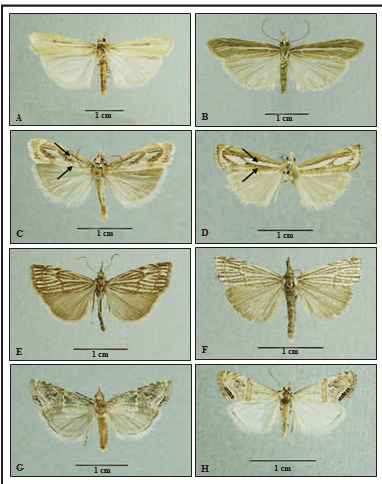
A-B) Agriphila deliella (Hb.), male: A) yellowish form. B) yellowish grey form. C) Catoptria pfeifferi (Osth.), male; upper and lower arrows indicate the relatively short proximal cell and faded away lower margin of the forewing, respectively. D) Catoptria colchicellus (Led.), female; upper and lower arrows indicate elongated proximal cell and distinct lower margin of the forewing, respectively. E-F) Chrysocramboides craterella (Scop.), male: E) dark brown form. F) light brown form. G) Euchromius keredjella (Ams.), male. H). Euchromius malekalis Ams., male.
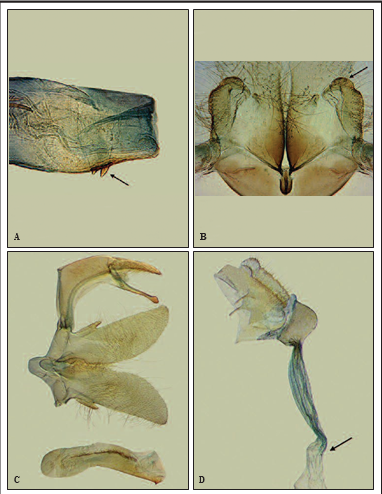
Genitalia. A) end of phallus in Agriphila poliellus (Tr.); arrow indicates the small thorns on the ventroapical part. B) smooth costal arms in the male genitalia of Agriphila poliellus (Tr.). C) male genitalia in Agriphila tristella ([D. & Schiff.]), D) posterior end of the female genitalia in Agriphila tristella ([D. & Schiff.]) arrow indicates narrow distal end of ductus bursa.
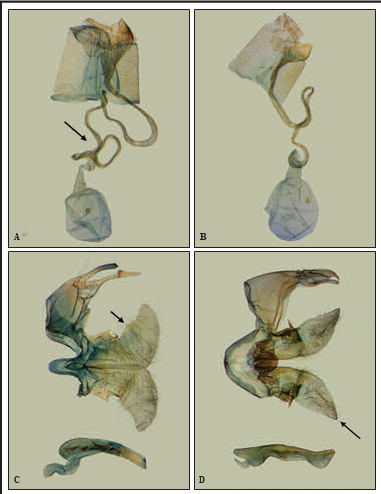
Genitalia. A) female genitalia in Catoptria colchicellus (Led.); arrow indicates the twists of ductus bursa. B) female genitalia in Catoptria dimorphellus (Stgr.). C) male genitalia in Euchromius ocellea (Hw.); arrow indicates the serrated swelling of the upper side of valva. D) male genitalia in Metacrambus kurdistanellus (Ams.); arrow indicates the pointed apex of cucullus.
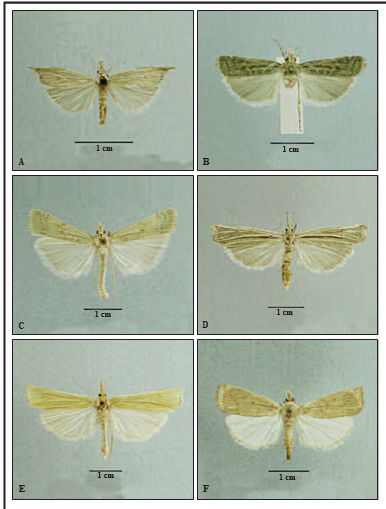
A) Metacrambus jugaraicae Blesz., female. B-C) Talis quercellus ([D. & Schiff.]): B) female. C) male. D-E) Ancylolomia palpella ([D. & Schiff.]), adult female: D) greyish form. E) amber-coloured form. F) Calamotropha paludella (Hb.), female.
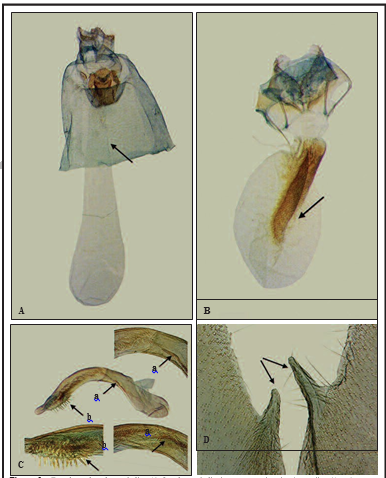
Female and male genitalia. A) female genitalia in Metacrambus kurdistanellus (Ams.); arrow indicates indistinguishable junction of ductus bursa and corpus bursa. B) female genitalia in Ancylolomia tripolitella Rbl.; arrow indicates the extended sclerotized area of antrum. C) phallus in Pediasia contaminella (Hb.); arrows indicate: (a) the small, more or less elongated cornutus and series of tiny thorns positioned longitudinally next to it, (b) brush-like spines on the apicoventral side of phallus. D) a part of male genitalia in Talis quercella ([D. & Schiff.]); arrow indicates the asymmetrical saccular processes.
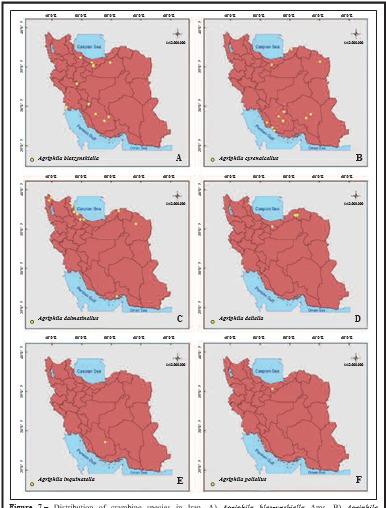
Distribution of crambine species in Iran. A) Agriphila bleszynskiella Ams. B) Agriphila cyrenaicellus (Rag.). C) Agriphila dalmatinellus (Hamps.). D) Agriphila deliella (Hb.). E) Agriphila inquinatella ([D. & Schiff.]). F) Agriphila poliellus (Tr.)
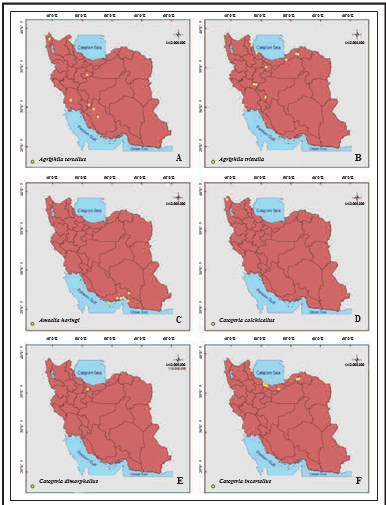
Distribution of crambine species in Iran based on the examined specimens. A) Agriphila tersellus (Led.). B) Agriphila tristella ([D. & Schiff.]). C) Amselia heringi (Ams.). D) Catoptria colchicellus (Led.). E) Catoptria dimorphellus (Stgr.). F) Catoptria incertellu (H.-S.)
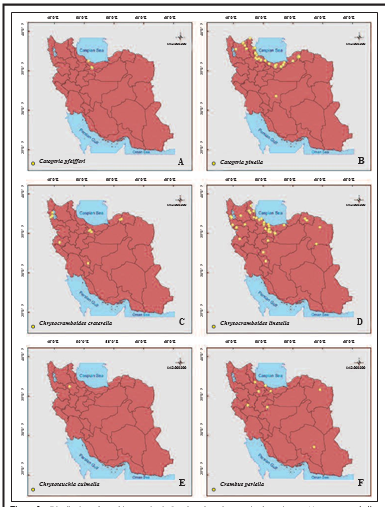
Distribution of crambine species in Iran based on the examined specimens. A) Catoptria pfeifferi (Osth.). B) Catoptria pinella (L.). C) Chrysocramboides craterella (Scop.). D) Chrysocrambus linetella (F.). E) Chrysoteuchia culmella (L.). F) Crambus perlella (Scop.).
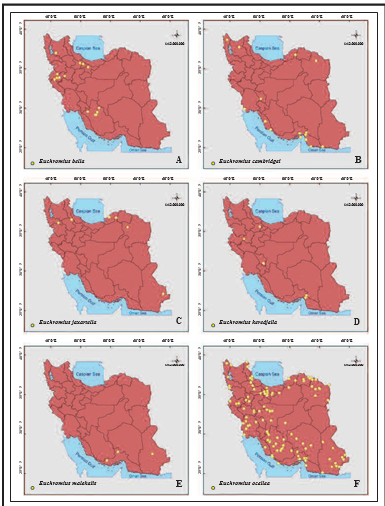
Distribution of crambine species in Iran based on the examined specimens. A) Euchromius bella (Hb.). B) Euchromius cambridgei (Z.). C) Euchromius jaxartella (Ersch.). D) Euchromius keredjella (Ams.). E) Euchromius malekalis (Ams.). F) Euchromius ocellea (Hw.).
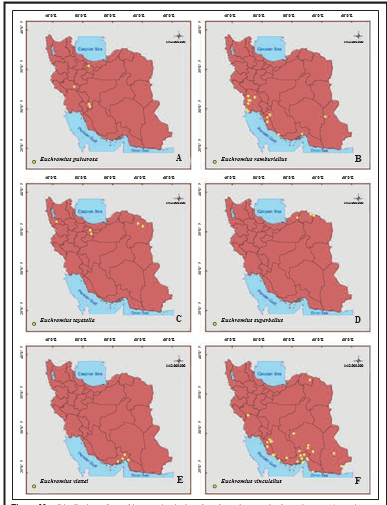
Distribution of crambine species in Iran based on the examined specimens. A) Euchromius pulverosa (Chr.). B) Euchromius ramburiellus (Dup.). C) Euchromius tayatella (Ams.). D) Euchromius superbellus (Z.). E) Euchromius viettei Blesz. F) Euchromius vinculellus (Z.)
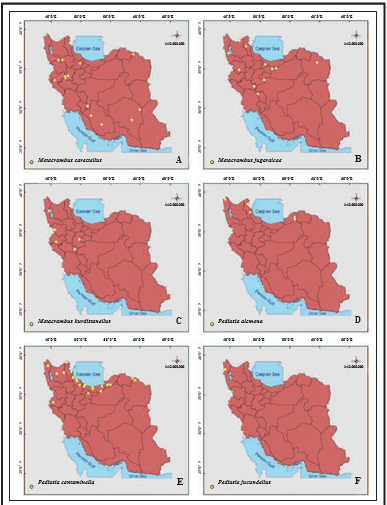
Distribution of crambine species in Iran based on the examined specimens A) Metacrambus carectellus (Z.). B) Metacrambus jugaraicae Blesz. C) Metacrambus kurdistanellus (Ams.). D) Pediasia alcmena Blesz. E) Pediasia contaminella (Hb.). F) Pediasia jucundellus (H.-S.)
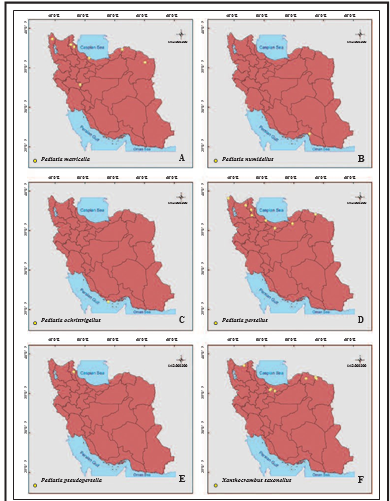
Distribution of crambine species in Iran based on the examined specimens A) Pediasia matricella (Tr.). B) Pediasia numidellus (Rbl.). C) Pediasia ochristrigellus (Hamps.). D) Pediasia persellus (Toll). E) Pediasia pseudopersella Blesz. F) Xanthocrambus saxonellus (Zck.).
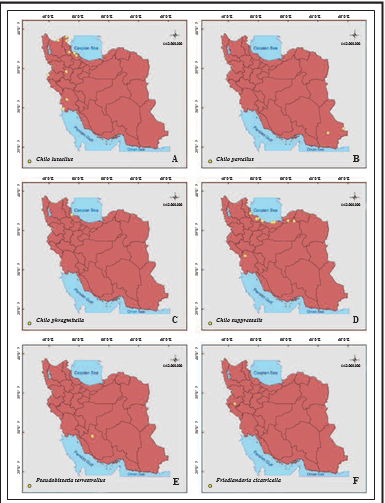
Distribution of crambine species in Iran based on the examined specimens A) Chilo luteellus (Motsch.). B) Chilo partellus (Swinh.). C) Chilo phragmitella (Hb.). D) Chilo suppressalis (Wlk.). E) Pseudobissetia terrestrellus (Chr.). F) Friedlanderia cicatricella (Hb.)
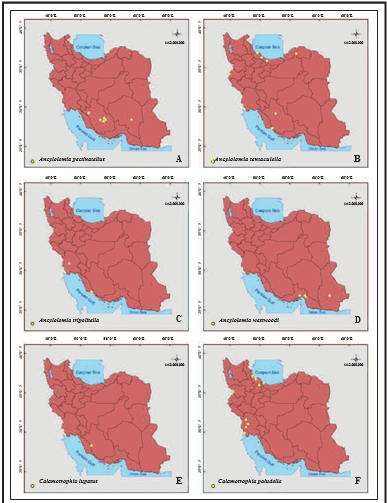
Distribution of crambine species in Iran based on the examined specimens A) Thopeutis galleriellus (Rag.). B) Surattha soudanensis Hamps. C) Talis quercella ([D. & Schiff.]). D) Talis renetae Gnv. & Hack. E) Ancylolomia micropalpella (Ams.) F) Ancylolomia palpella ([D. & Schiff.]).
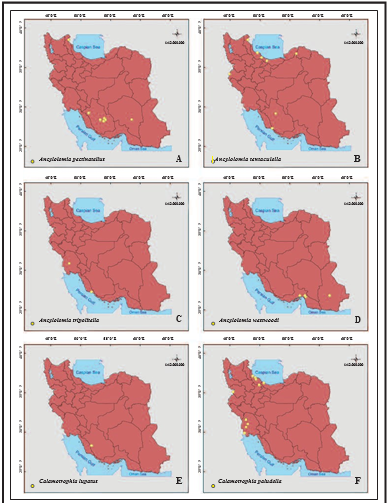
Distribution of crambine species in Iran based on the examined specimens A) Ancylolomia pectinatellus (Z.). B) Ancylolomia tentaculella (Hb.). C) Ancylolomia tripolitella (Rbl.). D) Ancylolomia westwoodi (Z.). E) Calamotropha lupatus (Meyr.). F) Calamotropha paludella (Hb.).
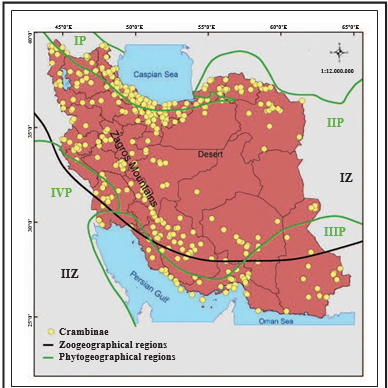
Overall distribution map of the examined crambine species in Iran with zoogeographical (Black line) (after EMELJANOV (1974) and Phytogeographical regions (Green lines) (after ZOHARY (1973) and FREY & PROBST (1986)). Roman numerals indicate Phytogeographical (Green) and Zoogeographical (Black) regions of Iran: IP, Euro-Siberian. IIP, Irano-Turanian. IIIP, Nubo-Sindian. IVP, Saharo-Arabian. IZ, Irano- Turanian. IIZ, Saharo-Arabian.
BIBLIOGRAPHY
AGNEW, C. W., 1987.– Status of Acigona Hübner (sensu Bleszyn´ski) (Lepidoptera: Pyralidae: Crambinae) with changes in nomenclature.– Proceedings of the Entomological Society of Washington, 89(1): 100-102.
ALIPANAH, H., 2003.– Faunal Study of Euchromius Guenée (Lepidoptera: Pyralidae: Crambinae) Species in Iran.– Journal of Entomological Society of Iran, 23(1): 115-134.
AMSEL, H. G., 1935.– Neue palästinensische Lepidopteren.– Mitteilungen aus dem Zoologischen Museum in Berlin, 20(1934) (2): 271-320, pls 10-12.
AMSEL, H. G., 1949a.– Die Microlepidopteren der Brandt’schen Iran-Ausbeute. 1. Teil.– Bulletin de la Société Fouad Ier d’Entomologie, 33: 227-269, 4 pls.
AMSEL, H. G., 1949b.– On the Microlepidoptera collected by E. P. Wiltshre in Irak and Iran in the years 1935 to 1938.– Bulletin de la Société Fouad 1er d’Entomologie, 33: 271-351 , pls 1-12.
AMSEL, H. G. 1951.– Die Microlepidopteren der Brandt’schen Iran-Ausbeute. 3. Teil.– Arkiv för Zoologi (N. S.), (ser.2) 1(36): 525-563.
AMSEL, H. G., 1954.– Die Microlepidopteren der Brandt’schen Iran-Ausbeute. 4. Teil.– Arkiv för Zoologi (N. S.), (ser.2) 6(16): 255-326, pls 1-33.
AMSEL, H. G., 1959a.– Microlepidoptera aus Iran.– Stuttgarter Beiträge zur Naturkunde, (28): 1-47.
AMSEL, H. G., 1959b.– Irakische Kleinschmetterlinge, II.– Bulletin de la Société Entomologique d’Égypte, Le Caire, 43: 41-83.
AMSEL, H. G., 1961.– Die Microlepidopteren der Brandt’schen Iran-Ausbeute. 5. Teil.– Arkiv för Zoologie (ser. 2) 13 (17): 323-445, pls. 1-9.
ANDERSON, S. C., 1968.– Zoogeographic analysis of the lizard fauna, pp. 305-371.– InW. B. FISHER (Ed). The Cambridge History of Iran, The Land of Iran, .: xxii + 766 pp. Cambridge University Press, London.
BASSI, G., 2013.– Notes on some Old World Prionapterygini Landry, 1995 (Lepidoptera: Pyraloidea, Crambidae, Crambinae), with descriptions of new species.– Revue suisse de zoologie, Genève, 120 (1): 131-160.
BLESZYN´ SKI, S., 1959.– Materialien zur Kenntnis der Crambinae. 21. Teil. Studien über einzelne Crambinae aus dem Nahen Osten (Lepidoptera: Pyralidae).– Beiträge zur Naturkundlichen Forschung in Südwestdeutschland, 18 (1): 112-116, pl. 3.
BLESZYN´ SKI, S., 1961.– Studies on the Crambidae (Lepidoptera). Part XXVI. Preliminary study on the genus Euchromius Gn.– Acta Entomologica Musei Nationalis Pragae, Praha, 34: 451-468.
BLESZYN´ SKI, S., 1965.– Crambinae. - In H. G. AMSEL, F. GREGOR & H. REISSER (Eds). Microlepidoptera Palaearctica, .(1): l + 553 pp., (2): 133 pls. Georg Fromme & Co., Wien.
BLESZYN´ SKI, S. & COLLINS, R. J., 1962.– A Short Catalogue of World Species of Family Crambidae (Lepidoptera).– Acta Zoologica Cracoviensia, .: 1-389.
CARADJA, A. V., 1910.– Beitrag zur Kenntnis über die geographische Verbreitung der Pyraliden des europäischen Faunengebietes nebst Beschreibung einiger neuer Formen.– Deutsche entomologische Zeitschrift Iris, Dresden, 24 (6-7): 105-147.
CHRISTOPH, H. T., 1885.– Lepidoptera aus dem Achal-Tekke-Gebiete. Zweiter Theil.– InN. M. ROMANOFF (Ed.). Mémoires sur les Lépidoptères, .: 119-171, pls 6-8, 15. St. Petersburg.
CHRISTOPH, H. T., 1888.– Zu einigen neuen Lepidopteren des palaearctischen Faunengebietes.– Trudy Russkago Entomologiceskago Obscestva, 22: 308-314.
CLARKE, J. F. G., 1941.– The preparation of slides of the genitalia of Lepidoptera.– Bulletin of the Brooklyn Entomological Society, 36: 149-161.
DENNIS, J. N. C. M. & SCHIFFERMÜLLER, I., 1775.– Ankündung eines systematischen Werkes von den Schmetterlingen der Wienergegend herausgegeben von einigen Lehrern am k.k. Theresianum: 323 pp., pls. 1-3. Augustin Bernardi, Wien.
DUPONCHEL, P. A. J., 1836-[1837].– Histoire naturelle des Lépidoptères ou Papillons de France, Paris. Nocturnes 7, 10: 1-384, errata et addenda, pls 267-286.
EBERT, G., 1973.– The rice stem borer Chilo suppressalis Walker (Lep: Pyral), a new pest for Iran.– Entomologie et Phytopathologie Appliquées, 35: 1-25.
EMELJANOV, A. F., 1974.– Proposals on the Classification and Nomenclature of Ranges.– Entomological Review, 53(3): 11-26.
ERSCHOFF, N. G., 1874.– Lepidoptera.– In A. P. FEDSCHENKO (Ed.). Journey to Turkestan. Mémoires de la Société des amis de sciences naturelles. Moscou, 11(2): [4] + VI + 127 pp., pls 1-6.
FABRICIUS, J. C., 1781-[1782].– Species insectorum exhibentes eorum differentias specificas, synonyma auctorum, loca natalia, metamorphosin adiectis observationibus, descriptionibus.– Impensis Carol. Ernest. Bohnii, Hamburgi et Kilonii. 1-494, 495-514 (appendix), 515-517 (index).
FALKOVICH, M. I. 1997.– Family Crambidae. pp. 589-668.– In G. S. MEDVEDEV (Ed). Keys to the Insects of the European Part of the USSR. Vol. 4. Lepidoptera. Part 3: 690 pp. Nauka publisher, Leningrad.
FAZEKAS, I., 1991.– Agriphila tolli beieri Bleszyn´ski, 1955 status no vus (Lepidoptera: Crambidae).– Annalen des Naturhistorischen Museum in Wien, 92: 113-119.
FAZEKAS, I., 2002.– Die taxonomische und tiergeographische Revision des Artenpaares Catoptria confusella (Staudinger, 1882) und Catoptria incertella (Herrich-Schäffer, 1852) (Lepidoptera:Crambidae).– Quadrifina, 5: 1-16.
FAZEKAS, I., 2011.– Revision of the Hungarian Euchromius Guenée, 1845 species (Lepidoptera: Crambidae).– Natura Somogyiensis, 19: 235-244.
FREY, W. & PROBST, P., 1986.– A synopsis of the vegetation of Iran. pp. 9-43.– In H. KIIRSCHNER (Ed). Contributions to the Vegetation of Southwest Asia. Dr. Ludwig Reichert Verlag.
GANEV, J. & HACKER, H., 1984.– Beitrag zur Kenntnis der Microlepidopteren der Türkei. Die Crambidae (Lepidoptera, Pyraloidea) der Ausbeute H. Hacker aus dem Jahr 1983 nebst Beschreibung neuer Taxa.– Nota lepidopterologica, 7 (3): 237-250.
GANEV, J. & HACKER, H., 1985.– Weiterer Beitrag zur Kenntnis der Crambidae Griechenlands und der Türkei. - Nota lepidopterologica, 87: 329-330.
HAMPSON, G. F., 1896.– On the classification of the Schoenobiinae and Crambinae, two subfamilies of moths, of the family Pyralidae.– Proceedings of the General Meetings for Scientific Business of the Zoological Society of London, 1895(4): 897-974.
HAMPSON, G. F., 1900.– New Palaearctic Pyralidae.– Transactions of the Entomological Society of London, 369- 401, pl. 3
HAMPSON, G. F., 1919.– Descriptions of new Pyralidae of the subfamilies Crambinae and Siginae.– Annals and Magazine of Natural History, including Zoology, Botany and Geology, London, (ser. 9) 4: 53-68, 137-154, 305-326.
HANNEMANN, H. J., 1964.– Kleinschmetterlinge oder Microlepidoptera II . Die Wickler (s. 1.) (Cochylidae und Carposinidac). Die Zünslerartigen (Pyraloidea).– Die Tierwelt Deutschlands, 50: vii + 360 pp., 22 pls.
HAWORTH, A. H., 1811.– Lepidoptera Britannica; sistens digestionem novam insectorum lepidopterorum quae in Magna Britannia reperiuntur, larvarum pabulo, tempo-reque pascendi; expansione alarum; mensiusque volandi; synonymis atque locis observationibusque variis, Part III: 377-511. J. Murray, Londini.
HERRICH-SCHÄFFER, G. A. W., (1847)-1849-(1855).– Systematische Bearbeitung der Schmetterlinge von Europa, zugleich als Text, Revision und Supplement zu Jakob Hübner’s Sammlung europäischer Schmetterlinge. Die Zünsler und Wickler.– Georg Joseph Manz in Regensburg, 4: [1]-2-288, (Index) [1]-2-48, pls. 1-23 (Pyralidides) + 1-59 (Tortricides). Regensburg.
HÜBNER, J., 1796-[1836].– Sammlung europäischer Schmetterlinge. 8. Horde. Die Schaben; nach der Natur geordnet, beschrieben und vorgestellt (continued by C. Geyer): [1]-[12]-13-70-[71]-[78], pls 1-71. Augsburg
HÜBNER, J., [1808]-1818.– Zuträge zur Sammlung exotischer Schmettlinge [sic], bestehend in genauer und richtiger Bekundigung einzel ermorbener Bildermufter neurfunbener americanischer und columbianischer Schmetterlinggattungen, 1: [1]-[3]-4-6-[7]-8-32-[33]-[40], pls [1]-[35]. Augsburg.
HÜBNER, J., 1816-[1825].– Verzeichniß bekannter Schmettlinge [sic].– bey dem Verfasser zu finden, Augsburg. (Verzeichniß) [1]-[3]-4-6-[7]-8-43. (Anzeiger) [1]-2-72.
KARSHOLT, O. & RAZOWSKI, J., 1996.– The Lepidoptera of Europe. A Distributional Checklist: 380 pp. Apollo Books, Stenstrup.
KLEIN, J. C., 1982.– Les groupements chionophiles de l’Alborz central (Iran). Comparaison avec leurs homolegues d’ Asie centrale.– Phytocoenologia, 10 (4): 463-486
KLEIN, J. C., 1991.– Endemisme a l’etage alpin de l’Alborz (Iran).– Flora et Vegetatio Mundi, 9: 247-261
KONSTANTINOV, V. A., REVYAKIN, V. P. & SAGAN V. V., 2009.– Heat transfer in solid halogenated methanes: trifluoromethane.– Low Temperature Physics, 35 (4): 286-289.
KRISTENSEN, N. P., 2003.– Skeleton and muscles: adults. pp. 39-131.– In N. P. KRISTENSEN (Ed.). Lepidoptera, Moths and Butterflies. Morphology, Physiology, and Development, The Handbook of Zoology/ Handbuch der Zoologie, 2: 564 pp. Walter de Gruyter, Berlin and New York.
KRYZHANOVSKY, O. L., 2002.– Composition and distribution of global entomofaunas: 238 pp. Tovar. Nautschn., Moskva. (In Russian)
LEDERER, J., 1855.– Beitrag zur Schmetterlings-Fauna von Cypern, Beirut und einem Theile Klein-Asiens.– Verhandlungen des zoologisch-botanischen Vereins in Wien, 5 (Abhandlungen): 177-254, pls 1-5.
LEDERER, J., 1869.– Verzeichniss der von Herrn Jos. Haberhauer bei Astrabad in Persien gesammelten Schmetterlinge.– Horae Societatis Entomologicae Rossicae, 6: 6-93, 5 pls.
LEDERER, J., 1870.– Contributions à la faune des Lépidoptères de la Transcaucasie.– Annales de la Société Entomologique de Belgique, 13: 17-54, pls 1-2.
LEDERER, J., 1871.– Nachtrag zum verzeichnisse Verzeichniss der von Herrn Jos. Haberhauer bei Astrabad in Persien gesammelten Schmetterlinge.– Horae Societatis Entomologicae Rossicae, 8: 3-28.
LERAUT, P. J. A., 2012.– Papillons de nuit d’Europe. Zygènes, Pyrales 1 et Brachodides, 3: 599 pp. N. A. P. Editions, Verrières-le-Buisson.
LI, W. C. & LI, H. H., 2011.– One new species of the genus Pediasia Hübner, [1825] from China.– SHILAP Revista de lepidopterología, 39(154): 235-239.
LINNAEUS, C., 1758.– Systema Naturae per regna tria naturae, secundum classes, ordines genera, species, cum characteribus, differentiis, synonymis, locis, Editio decima, (1): 534 pp. Holmiae
MEYRICK, E., 1930-1936.– Exotic Microlepidoptera, 1: 642 pp. Taylor and Francis, London.
MIRZAYANS, H., & KALALI, G., 1970.– Contribution à la connaissance de la faune des lépidoptéres de l’Iran (2).– Entomologie et Phytopathologie Appliquées, 29: 15-23.
MOTSCHULSKY, V. I., 1866.– Catalogue des insectes reçus de Japon.– Bulletin de la Société Impériale des Naturalistes de Moscou, 39(1): 163-200.
MOZAFFARIAN, F., 2013.– A preliminary study on the distribution patterns of endemic species of Fulgoromorpha (Hemiptera, Auchenorrhyncha) in Iran.– ZooKeys, 319: 231-248.
NUSS, M., LANDRY, B., VEGLIANTE F., TRÄNKNER, A., MALLY, R., HAYDEN, J., SEGERER, A., LI, H., SCHOUTEN, R., SOLIS, M. A., TROFIMOVA, T., DE PRINS, J. & SPEIDEL, W., 2003-2015.– Global Information System on Pyraloidea. Available from http//: www.pyraloidea.org.
OSTHELDER, L., 1938.– Neue Kleinfalter aus dem Tahte Soleiman in Nord-Persien. (Lep.).– Mitteilungen der Münchener Entomologischen Gesellschaft, 28(1): 17-29.
RAGONOT, E. L., 1887.– Les diagnoses suivantes de diverses espèces inédites de Microlépidoptères provenant de Gabès (Tunisie), récoltées par notre collègue M. le capitaine Ch. Dattin.– Bulletin de la Société entomologique de France: cxxxvii-cxxxix.
REBEL, H., 1903.– Eine Heteroceren-Ausbeute aus der Sahara II.– Verhandlungen der Zoologisch-Botanischen Gesellschaft in Wien, 53: 404-415.
REBEL, H., 1909.– Lepidopteren aus Tripolis und Barka, Gesammelt von Dr. Bruno Klaptocz.– Zoologische Jahrbücher, Jena, 27: 273-290.
ROBINSON, G. S., 1976.– The preparation of slides of Lepidoptera genitalia with special reference to the Microlepidoptera.– Entomologist’s Gazette, 27: 127-132.
ROMANOFF, N. M., 1887.– Les Lépidoptères de la Transcaucasie. Troisième partie.– In N. M. ROMANOFF (Ed.). Mémoires sur les Lépidoptères, 3: 1-49, pls 1-2. St. Petersburg.
ROTHSCHILD, L. W., 1913.– Expedition to the central western Sahara by Ernst Hartert. VII. Lepidoptera.– Novitates Zoologicae, 20: 109-143
SCHOUTEN, R. T. A., 1992.– Revision of the species of the genus Euchromius Guenée, 1845 (Lepidoptera: Pyralidae: Crambinae) occurring in the Afrotropical Region.– Zoologische Verhandelingen, 244: 1-64.
SCOPOLI, J. A., 1763.– Entomologia Carniolica exhibens insecta Carnioliae indigena et distributa in ordines, genera, species, varietates, methodo Linneana: 2]+[8]+[22]+420+[4] p. [43] plates. Joannis Thomae Trattner, Vienna.
SLAMKA, F., 2008.– Pyraloidea of Europe. Crambinae & Schoenobiinae, 2: 223 pp. Frantisˇek. Slamka Ed., Bratislava.
STAUDINGER, O., 1881.– Lepidopteren-Fauna Kleinasien’s. Nachträge.– Horae Societatis entomologicae Rossicae, 16(1/2): 65-135.
STAUDINGER, O., 1892.– Lepidopteren aus Tunis.– Deutsche entomologische Zeitschrift, Iris, 5: 277-300
SWINHOE, C., 1886.– On the Lepidoptera of Bombay and the Deccan. Part IV. Heterocera (continued).– Proceedings of the General Meetings for Scientific Business of the Zoological Society of London, 1885(4): 852-886, pls 56-57.
TOLL, S., 1948.– Beitrag zur Mikrolepidopterenfauna von Nordost-Persien.– Zeitschrift der Wiener entomologischen Gesellschaft, 32 (1947): 107-116, pls. 4-6.
TREITSCHKE, F., 1832.– Die Schmetterlinge von Europa (Fortsetzung des Ochsenheimer’schen Werks): viii + 272. Ernst Fleischer, Leipzig
WALKER, F., 1863.– Crambites & Tortricites.– List of the Specimens of Lepidopterous Insects in the Collection of the British Museum, London, 27: 1-286.
WIESER, C., HUMER, P. & STANGELMAIER, G., 2001.– Schmetterlinge (Lepidoptera).– In B. GUTLEB & C. WIESER (Eds). Nordiran. Ergebnisse einer Zoologischen Exkursion. Carinthia II (Klagenfurt), 192(112): 52- 81.
ZARUDNY, N. A., 1911.– Verzeichnis der Vögel Persiens.– Journal für Ornithologie, 59: 185-241. (doi: 10.1007/BF02091053).
ZELLER, P. C., 1847a.– Bemerkungen über die auf einer Reise nach Italien und Sicilien beobachteten Schmetterlingsarten.– Isis von Oken, 40(2): 121-159, (3): 213-233, (3): 284-308, (6): 401-457, (7): 481-522, (8): 561-594, (9): 639-673.
ZELLER, P. C., 1847b.– Verzeichnis der vom Professor Dr. Loew in der Türkey und Asien gesammelten Lepidoptera.– Isis von Oken, 40: 3-39.
ZELLER, P. C., 1849.– Verzeichnis der von Herrn Jos. Mann beobachteten Toscanischen Microlepidoptera.– Entomologische Zeitung, Stettin, 10(7): 200-223, (8): 231-256, (9): 275-287, (10): 312-317.
ZELLER, P. C., 1863.– Chilonidarum et Crambidarum genera et species: 1-56. Wiegandt & Hempel, Meseritz & Berlin.
ZELLER, P. C., 1867 [May].– Choreutidae and Crambina, collected in Egypt, by the Rev. O. P. Cambridge, January to April, 1864.– Transactions of the Entomological Society of London, (ser. 3) 5(6): 461-466, pl. 24.
ZERNY, H., 1934.– Lepidopteren aus dem nördlichen Libanon. Mit Beiträgen von Dr. A. Corti, (Zürich), F. Daniel (München), L. Schwingenschuss (Wien) und Dr. E. Wehrli (Basel). (Schluß).– Deutsche entomologische Zeitschrift, Iris, 48(1): 1-28.
ZERNY, H., 1939.– Microlepidopteren aus dem Elburs-Gebirge in Nord Iran.– Zeitschrift des Wiener Entomologen- Verains, 24: 130-142
ZINCKEN, J. L. T. F., 1821.– Nachtrag zur Monographie der Gattung Chilo.– Magazin der Entomologie, 4: 246- 258.
ZOHARY, M., 1963.– On the geobotanical structure of Iran.– The Bulletin of the Research Council of Israel, 11D supplementary: 1-113.
ZOHARY, M., 1973.– Geobotanical foundations of the Middle East, 1-2: xxiv + 739 pp. Gustav Fischer Verlag- Stuttgar / Swets & Zeitlinger, Amsterdam.